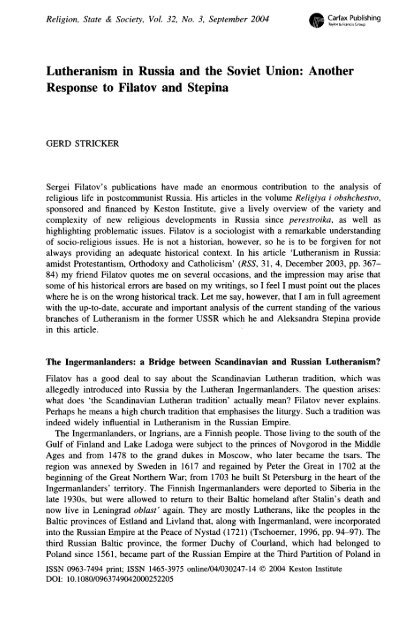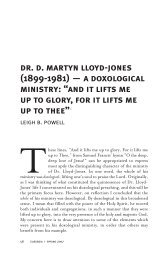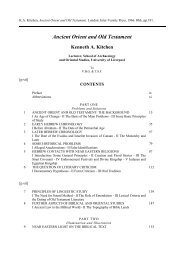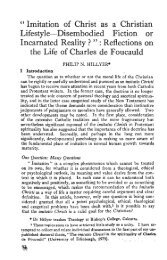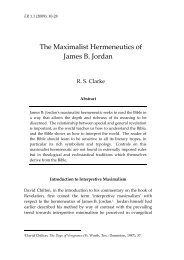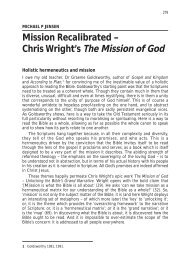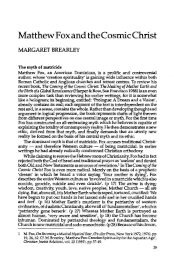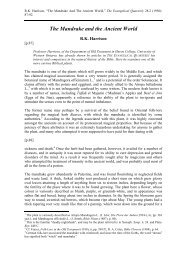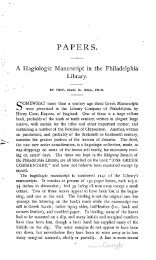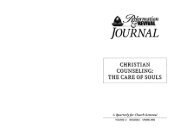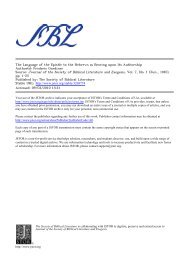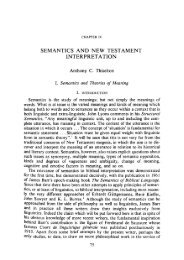Lutheranism in Russia and the Soviet Union: Another Response to ...
Lutheranism in Russia and the Soviet Union: Another Response to ...
Lutheranism in Russia and the Soviet Union: Another Response to ...
Create successful ePaper yourself
Turn your PDF publications into a flip-book with our unique Google optimized e-Paper software.
Religion, State & Society, Vo!. 32, No. 3, September 2004<br />
Carfax Publish<strong>in</strong>g<br />
• rtI Taylor&FranclsGroup<br />
<strong>Lu<strong>the</strong>ranism</strong> <strong>in</strong> <strong>Russia</strong> <strong>and</strong> <strong>the</strong> <strong>Soviet</strong> <strong>Union</strong>: Ano<strong>the</strong>r<br />
<strong>Response</strong> <strong>to</strong> Fila<strong>to</strong>v <strong>and</strong> Step<strong>in</strong>a<br />
GERD STRICKER<br />
Sergei Fila<strong>to</strong>v's publications have made an enormous contribution <strong>to</strong> <strong>the</strong> analysis of<br />
religious life <strong>in</strong> postcommunist <strong>Russia</strong>. His articles <strong>in</strong> <strong>the</strong> volume Religiya i obshchestvo,<br />
sponsored <strong>and</strong> f<strong>in</strong>anced by Kes<strong>to</strong>n Institute, give a lively overview of <strong>the</strong> variety <strong>and</strong><br />
complexity of new religious developments <strong>in</strong> <strong>Russia</strong> s<strong>in</strong>ce perestroika, as well as<br />
highlight<strong>in</strong>g problematic issues. Fila<strong>to</strong>v is a sociologist with a remarkable underst<strong>and</strong><strong>in</strong>g<br />
of socio-religious issues. He is not a his<strong>to</strong>rian, however, so he is <strong>to</strong> be forgiven for not<br />
always provid<strong>in</strong>g an adequate his<strong>to</strong>rical context. In his article '<strong>Lu<strong>the</strong>ranism</strong> <strong>in</strong> <strong>Russia</strong>:<br />
amidst Protestantism, Orthodoxy <strong>and</strong> Catholicism' (RSS, 31, 4, December 2003, pp. 367-<br />
84) my friend Fila<strong>to</strong>v quotes me on several occasions, <strong>and</strong> <strong>the</strong> impression may arise that<br />
some of his his<strong>to</strong>rical errors are based on my writ<strong>in</strong>gs, so I feel I must po<strong>in</strong>t out <strong>the</strong> places<br />
where he is on <strong>the</strong> wrong his<strong>to</strong>rical track. Let me say, however, that I am <strong>in</strong> full agreement<br />
with <strong>the</strong> up-<strong>to</strong>-date, accurate <strong>and</strong> important analysis of <strong>the</strong> current st<strong>and</strong><strong>in</strong>g of <strong>the</strong> various<br />
branches of <strong>Lu<strong>the</strong>ranism</strong> <strong>in</strong> <strong>the</strong> former USSR which he <strong>and</strong> Aleks<strong>and</strong>ra Step<strong>in</strong>a provide<br />
<strong>in</strong> this article.<br />
The Ingermanl<strong>and</strong>ers: a Bridge between Sc<strong>and</strong><strong>in</strong>avian <strong>and</strong> <strong>Russia</strong>n <strong>Lu<strong>the</strong>ranism</strong>?<br />
Fila<strong>to</strong>v has a good deal <strong>to</strong> say about <strong>the</strong> Sc<strong>and</strong><strong>in</strong>avian Lu<strong>the</strong>ran tradition, which was<br />
allegedly <strong>in</strong>troduced <strong>in</strong><strong>to</strong> <strong>Russia</strong> by <strong>the</strong> Lu<strong>the</strong>ran Ingermanl<strong>and</strong>ers. The question arises:<br />
what does '<strong>the</strong> Sc<strong>and</strong><strong>in</strong>avian Lu<strong>the</strong>ran tradition' actually mean? Fila<strong>to</strong>v never expla<strong>in</strong>s.<br />
Perhaps he means a high church tradition that emphasises <strong>the</strong> liturgy. Such a tradition was<br />
<strong>in</strong>deed widely <strong>in</strong>fluential <strong>in</strong> <strong>Lu<strong>the</strong>ranism</strong> <strong>in</strong> <strong>the</strong> <strong>Russia</strong>n Empire.<br />
The Ingermanl<strong>and</strong>ers, or Ingrians, are a F<strong>in</strong>nish people. Those liv<strong>in</strong>g <strong>to</strong> <strong>the</strong> south of <strong>the</strong><br />
Gulf of F<strong>in</strong>l<strong>and</strong> <strong>and</strong> Lake Ladoga were subject <strong>to</strong> <strong>the</strong> pr<strong>in</strong>ces of Novgorod <strong>in</strong> <strong>the</strong> Middle<br />
Ages <strong>and</strong> from 1478 <strong>to</strong> <strong>the</strong> gr<strong>and</strong> dukes <strong>in</strong> Moscow, who later became <strong>the</strong> tsars. The<br />
region was annexed by Sweden <strong>in</strong> 1617 <strong>and</strong> rega<strong>in</strong>ed by Peter <strong>the</strong> Great <strong>in</strong> 1702 at <strong>the</strong><br />
beg<strong>in</strong>n<strong>in</strong>g of <strong>the</strong> Great Nor<strong>the</strong>rn War; from 1703 he built St Petersburg <strong>in</strong> <strong>the</strong> heart of <strong>the</strong><br />
Ingermanl<strong>and</strong>ers' terri<strong>to</strong>ry. The F<strong>in</strong>nish Ingermanl<strong>and</strong>ers were deported <strong>to</strong> Siberia <strong>in</strong> <strong>the</strong><br />
late 1930s, but were allowed <strong>to</strong> return <strong>to</strong> <strong>the</strong>ir Baltic homel<strong>and</strong> after Stal<strong>in</strong>'s death <strong>and</strong><br />
now live <strong>in</strong> Len<strong>in</strong>grad oblast' aga<strong>in</strong>. They are mostly Lu<strong>the</strong>rans, like <strong>the</strong> peoples <strong>in</strong> <strong>the</strong><br />
Baltic prov<strong>in</strong>ces of Estl<strong>and</strong> <strong>and</strong> Livl<strong>and</strong> that, along with Ingermanl<strong>and</strong>, were <strong>in</strong>corporated<br />
<strong>in</strong><strong>to</strong> <strong>the</strong> <strong>Russia</strong>n Empire at <strong>the</strong> Peace of Nystad (1721) (Tschoerner, 1996, pp. 94-97). The<br />
third <strong>Russia</strong>n Baltic prov<strong>in</strong>ce, <strong>the</strong> former Duchy of Courl<strong>and</strong>, which had belonged <strong>to</strong><br />
Pol<strong>and</strong> s<strong>in</strong>ce 1561, became part of <strong>the</strong> <strong>Russia</strong>n Empire at <strong>the</strong> Third Partition of Pol<strong>and</strong> <strong>in</strong><br />
ISSN 0963-7494 pr<strong>in</strong>t; ISSN 1465-3975 onl<strong>in</strong>e/04/030247-14 © 2004 Kes<strong>to</strong>n Institute<br />
DOl: 10.1080/0963749042000252205
248 Gerd Stricker<br />
1795. Estl<strong>and</strong>, Livl<strong>and</strong> <strong>and</strong> Courl<strong>and</strong> (<strong>to</strong>day's Es<strong>to</strong>nia <strong>and</strong> Latvia) had orig<strong>in</strong>ally been <strong>the</strong><br />
terri<strong>to</strong>ry of <strong>the</strong> Teu<strong>to</strong>nic Order, which from 1186 christianised <strong>the</strong> Baltic peoples of <strong>the</strong><br />
region (<strong>the</strong> Ests, Livs, Letts, Kurs <strong>and</strong> (later <strong>in</strong> German East Prussia) <strong>the</strong> <strong>in</strong>digenous<br />
Prussians (Pruzzen). Under <strong>the</strong> rule of <strong>the</strong> Order <strong>the</strong> <strong>in</strong>digenous peoples decl<strong>in</strong>ed <strong>in</strong><strong>to</strong> a<br />
peasant underclass, with <strong>the</strong> status virtually of serfs. The rul<strong>in</strong>g class were <strong>the</strong> descendants<br />
of <strong>the</strong> Teu<strong>to</strong>nic Knights, who owned <strong>the</strong> l<strong>and</strong> <strong>in</strong> <strong>the</strong> Baltic region <strong>and</strong> also de fac<strong>to</strong> owned<br />
<strong>the</strong> <strong>in</strong>habitants except for those who managed <strong>to</strong> rise <strong>in</strong><strong>to</strong> <strong>the</strong> German rul<strong>in</strong>g class; <strong>the</strong><br />
<strong>to</strong>wns were purely German; supplies from Germany never dried up. The Order built a state<br />
that as far as efficiency was concerned was a model for its time <strong>and</strong> for its location on<br />
<strong>the</strong> 'edge' of Europe. In <strong>the</strong> 1520s <strong>the</strong> German rul<strong>in</strong>g class <strong>in</strong> <strong>the</strong> Order's l<strong>and</strong>s, <strong>and</strong> even<br />
most of <strong>the</strong> clergy <strong>the</strong>re, embraced <strong>the</strong> Reformation; <strong>the</strong> leadership <strong>in</strong> Reval (now<br />
Tall<strong>in</strong>n), for example, <strong>in</strong>troduced it <strong>in</strong><strong>to</strong> Es<strong>to</strong>nia <strong>in</strong> 1524 (Kahle, 1985, p.34; Wittram,<br />
1956, pp. 35-86): this was earlier than <strong>in</strong> many o<strong>the</strong>r parts of <strong>the</strong> Holy Roman Empire.<br />
The Baltic serfs also compulsorily became Lu<strong>the</strong>rans: <strong>the</strong>y were not even asked (Wittram,<br />
1956, pp. 35-55). The l<strong>and</strong>s of <strong>the</strong> Order, now mostly Lu<strong>the</strong>ran, soon fell apart <strong>in</strong> <strong>the</strong><br />
Livl<strong>and</strong> War (1558-82/95). Estl<strong>and</strong> <strong>and</strong> Liv1<strong>and</strong> went <strong>to</strong> Sweden; Courl<strong>and</strong> (as mentioned<br />
above) came under Polish rule. They were already by now well-established Lu<strong>the</strong>ran<br />
prov<strong>in</strong>ces, which were regarded as 'German' <strong>and</strong> where <strong>the</strong> non-German peasant underclass<br />
was hardly heeded. Noth<strong>in</strong>g changed <strong>in</strong> <strong>the</strong> social setup throughout <strong>the</strong> 140 years of<br />
Swedish <strong>and</strong> <strong>the</strong> 220 years of Polish rule. It was <strong>the</strong> local German body of knights I that<br />
communicated with <strong>the</strong> Swedish <strong>and</strong> Polish k<strong>in</strong>gs. Under Swedish rule <strong>the</strong> <strong>Lu<strong>the</strong>ranism</strong><br />
of Estl<strong>and</strong> <strong>and</strong> Livl<strong>and</strong> received its Sc<strong>and</strong><strong>in</strong>avian stamp; with its German clergy <strong>and</strong> its<br />
German, Es<strong>to</strong>nian <strong>and</strong> Latvian congregations it became an <strong>in</strong>tegral part of Sc<strong>and</strong><strong>in</strong>avian<br />
<strong>Lu<strong>the</strong>ranism</strong>. Until almost <strong>the</strong> end of <strong>the</strong> n<strong>in</strong>eteenth century practically all pas<strong>to</strong>rs <strong>in</strong> <strong>the</strong><br />
Baltic prov<strong>in</strong>ces were German, but it was a condition of <strong>the</strong>ir ord<strong>in</strong>ation that <strong>the</strong>y should<br />
also be able <strong>to</strong> preach <strong>in</strong> Es<strong>to</strong>nian <strong>and</strong> Latvian. From <strong>the</strong> time of <strong>the</strong> Reformation German<br />
pas<strong>to</strong>rs laid <strong>the</strong> foundations of <strong>the</strong> later Es<strong>to</strong>nian <strong>and</strong> Latvian literary languages <strong>and</strong> <strong>the</strong>ir<br />
grammar, beg<strong>in</strong>n<strong>in</strong>g with translations of Mart<strong>in</strong> Lu<strong>the</strong>r's Small Catechism <strong>and</strong> o<strong>the</strong>r key<br />
Reformation texts.<br />
Noth<strong>in</strong>g changed <strong>in</strong> <strong>the</strong> situation when Peter <strong>the</strong> Great conquered <strong>the</strong> Baltic prov<strong>in</strong>ces.<br />
He granted Estl<strong>and</strong> <strong>and</strong> Livl<strong>and</strong> a de fac<strong>to</strong> <strong>in</strong>ner au<strong>to</strong>nomy, which <strong>in</strong>volved various<br />
privileges, <strong>and</strong> Ca<strong>the</strong>r<strong>in</strong>e <strong>the</strong> Great did <strong>the</strong> same for Courl<strong>and</strong> <strong>in</strong> 1795. German was<br />
designated <strong>the</strong> official language of adm<strong>in</strong>istration <strong>and</strong> <strong>Lu<strong>the</strong>ranism</strong> (not Orthodoxy) <strong>the</strong><br />
lead<strong>in</strong>g religion (first <strong>in</strong> Livl<strong>and</strong> <strong>and</strong> Estl<strong>and</strong>, <strong>and</strong> later <strong>in</strong> Courl<strong>and</strong>).<br />
Conservative Baltic German <strong>Lu<strong>the</strong>ranism</strong> was marked by Sc<strong>and</strong><strong>in</strong>avian features: it was<br />
high-church <strong>and</strong> liturgical. These features did not however suit <strong>the</strong> mentality of <strong>the</strong><br />
Es<strong>to</strong>nians <strong>and</strong> Latvians: <strong>the</strong>y preferred a pla<strong>in</strong> warm spontaneity <strong>to</strong> stiff ceremonial. The<br />
Pietist Graf Nikolaus Ludwig Z<strong>in</strong>zendorf, <strong>the</strong> founder of <strong>the</strong> Hermhut Brethren community<br />
<strong>in</strong> Saxony,2 spent a short time <strong>in</strong> <strong>the</strong> <strong>Russia</strong>n Baltic prov<strong>in</strong>ces <strong>in</strong> 1736, where <strong>the</strong><br />
Es<strong>to</strong>nian <strong>and</strong> Latvian peasants responded enthusiastically <strong>to</strong> his preach<strong>in</strong>g. The peasants<br />
did not (<strong>and</strong> could not) formally withdraw from <strong>the</strong> high church of <strong>the</strong>ir German masters,<br />
but <strong>the</strong>y saw <strong>the</strong> focus of <strong>the</strong>ir spiritual life <strong>in</strong> <strong>the</strong> Pietist 'brethren communities'<br />
(Briidergeme<strong>in</strong>schaften) (Wittram, 1956, pp. 149-65) which <strong>the</strong>y formed <strong>in</strong> Z<strong>in</strong>zendorfs<br />
spirit <strong>and</strong> for which <strong>the</strong>y built large prayer houses on <strong>the</strong> outskirts of <strong>the</strong>ir villages.<br />
Tension between <strong>the</strong>se 'brethren communities' <strong>and</strong> <strong>the</strong> official German church was<br />
frequently high, one reason be<strong>in</strong>g that at <strong>the</strong> time of Romanticism <strong>and</strong> 'national<br />
awaken<strong>in</strong>g' <strong>the</strong> brethren communities became national <strong>in</strong>stitutions for <strong>the</strong> Es<strong>to</strong>nians <strong>and</strong><br />
Latvians, which ever more opposed <strong>the</strong> German hegemony. National feel<strong>in</strong>gs amongst<br />
Es<strong>to</strong>nians, Latvians <strong>and</strong> F<strong>in</strong>nish Ingermanl<strong>and</strong>ers aga<strong>in</strong>st <strong>the</strong> German church leadership<br />
<strong>in</strong>creased dur<strong>in</strong>g <strong>the</strong> second half of <strong>the</strong> n<strong>in</strong>eteenth century with<strong>in</strong> <strong>the</strong> Evangelical Lu<strong>the</strong>ran
<strong>Lu<strong>the</strong>ranism</strong> <strong>in</strong> <strong>Russia</strong> <strong>and</strong> <strong>the</strong> <strong>Soviet</strong> <strong>Union</strong> 249<br />
Church <strong>in</strong> <strong>Russia</strong>, <strong>and</strong> not much could be done <strong>to</strong> tackle <strong>the</strong> causes of this tension until<br />
<strong>the</strong> First World War.<br />
In 1832 Emperor Nicholas I issued a decree establish<strong>in</strong>g <strong>the</strong> Evangelical Lu<strong>the</strong>ran<br />
Church <strong>in</strong> <strong>Russia</strong> (ELCR)3 which <strong>in</strong>cluded all Lu<strong>the</strong>rans <strong>in</strong> <strong>the</strong> Empire: Es<strong>to</strong>nians,<br />
Latvians, Germans <strong>and</strong> Ingermanl<strong>and</strong>ers. It also <strong>in</strong>cluded <strong>the</strong> Reformed congregations. 4<br />
The supreme bishop (summus episcopus) <strong>in</strong> this state church (as <strong>in</strong> <strong>the</strong> Orthodox Church)<br />
was <strong>the</strong> <strong>Russia</strong>n Emperor himself. Culturally this mult<strong>in</strong>ational church was German. The<br />
official language <strong>and</strong> l<strong>in</strong>gua franca <strong>in</strong> <strong>the</strong> church was German. Teach<strong>in</strong>g was <strong>in</strong> German<br />
at <strong>the</strong> <strong>the</strong>ological faculty of <strong>the</strong> German university <strong>in</strong> Dorpat (Tartu) <strong>in</strong> Livl<strong>and</strong> (founded<br />
1632, refounded 1802; now <strong>in</strong> Es<strong>to</strong>nia) where all Lu<strong>the</strong>ran <strong>and</strong> some Reformed <strong>the</strong>ologians<br />
<strong>in</strong> <strong>the</strong> <strong>Russia</strong>n Empire studied (with <strong>the</strong> exception of <strong>the</strong> pas<strong>to</strong>rs of <strong>the</strong><br />
Ingermanl<strong>and</strong>er parishes who were F<strong>in</strong>ns or studied <strong>in</strong> <strong>the</strong> Gr<strong>and</strong> Duchy of F<strong>in</strong>l<strong>and</strong>, also<br />
an au<strong>to</strong>nomous part of <strong>the</strong> <strong>Russia</strong>n Empire). The church leadership5 comprised almost<br />
exclusively Baltic Germans (some of Swedish orig<strong>in</strong>).6 At <strong>the</strong> same time, <strong>in</strong> its liturgical<br />
style this church was Sc<strong>and</strong><strong>in</strong>avian: first, because for a long time most of <strong>the</strong> Lu<strong>the</strong>ran<br />
pas<strong>to</strong>rs even <strong>in</strong> <strong>the</strong> <strong>in</strong>terior of <strong>the</strong> <strong>Russia</strong>n Empire had been Baltic Germans who had been<br />
thoroughly imbued <strong>in</strong> <strong>the</strong> Sc<strong>and</strong><strong>in</strong>avian style, <strong>and</strong> second, because <strong>the</strong> Dorpat <strong>the</strong>ological<br />
faculty was unambiguously Sc<strong>and</strong><strong>in</strong>avian <strong>in</strong> character <strong>and</strong> transmitted this even <strong>to</strong> those<br />
Germans who had been born <strong>in</strong> <strong>Russia</strong> <strong>and</strong> who started attend<strong>in</strong>g <strong>the</strong> faculty <strong>in</strong> <strong>in</strong>creas<strong>in</strong>g<br />
numbers <strong>in</strong> <strong>the</strong> last third of <strong>the</strong> n<strong>in</strong>eteenth century.<br />
The Lu<strong>the</strong>rans <strong>in</strong> <strong>Russia</strong> itself - from St Petersburg <strong>to</strong> Vladivos<strong>to</strong>k - had come <strong>to</strong><br />
<strong>Russia</strong> <strong>in</strong> various waves of immigration from all German states. They had been <strong>in</strong>vited by<br />
Ca<strong>the</strong>r<strong>in</strong>e <strong>the</strong> Great (<strong>the</strong> Volga Germans <strong>in</strong> 1763) <strong>and</strong> by Alex<strong>and</strong>er I (<strong>the</strong> Black Sea<br />
Germans <strong>in</strong> 1803). Ca<strong>the</strong>r<strong>in</strong>e herself was born a German pr<strong>in</strong>cess: Sophie Friederike<br />
Auguste von Anhalt-Zerbst. The Potestants among <strong>the</strong>m 7 brought <strong>the</strong> full variety of<br />
Lu<strong>the</strong>ran traditions with <strong>the</strong>m from <strong>the</strong>ir homel<strong>and</strong>s: Hessen, Wtirttemberg, Baden,<br />
Bavaria, Saxony, Mecklenburg. The Volga Germans left <strong>the</strong>ir homel<strong>and</strong>s for economic<br />
reasons, but a large proportion of <strong>the</strong> Black Sea Germans, Swabian Pietists, had accepted<br />
<strong>the</strong> <strong>in</strong>vitation <strong>to</strong> come <strong>to</strong> <strong>Russia</strong> for religious reasons. These Protestant Black Sea Germans<br />
with a def<strong>in</strong>ite Pietist background were particularly sensitive about religious matters. In<br />
<strong>the</strong>ir villages (<strong>in</strong> <strong>to</strong>day's sou<strong>the</strong>rn Ukra<strong>in</strong>e) conflicts between pas<strong>to</strong>rs <strong>and</strong> congregations<br />
often arose; <strong>the</strong>ir causes were a good deal more complex than Fila<strong>to</strong>v describes <strong>the</strong>m.<br />
In Wtirttemberg even <strong>to</strong>day <strong>Lu<strong>the</strong>ranism</strong> is liturgically much more modest than <strong>in</strong> North<br />
Germany or Sc<strong>and</strong><strong>in</strong>avia - or <strong>in</strong> <strong>the</strong> Baltic states at <strong>the</strong> time we are discuss<strong>in</strong>g. Pas<strong>to</strong>rs<br />
tra<strong>in</strong>ed at Dorpat <strong>and</strong> br<strong>in</strong>g<strong>in</strong>g <strong>the</strong>ir high-church liturgical ritual <strong>to</strong> <strong>the</strong> Black Sea<br />
Germans' villages met determ<strong>in</strong>ed resistance <strong>in</strong> Pietist parishes. The Swabian Pietists saw<br />
<strong>the</strong>m as representatives of a Baltic-Sc<strong>and</strong><strong>in</strong>avian tradition that <strong>the</strong>y rejected. Conflicts<br />
abated only from about 1860, when sons of <strong>the</strong> Black Sea (<strong>and</strong> also Volga German)<br />
colonists were able <strong>to</strong> study <strong>the</strong>ology at Dorpat <strong>and</strong> as pas<strong>to</strong>rs began <strong>to</strong> reconcile <strong>the</strong><br />
Sc<strong>and</strong><strong>in</strong>avian tradition with <strong>the</strong> tradition of <strong>the</strong>ir villages.<br />
It was thus Baltic German <strong>Lu<strong>the</strong>ranism</strong> with its Sc<strong>and</strong><strong>in</strong>avian stamp which was <strong>the</strong><br />
decisive formative <strong>in</strong>fluence on <strong>the</strong> whole of <strong>Lu<strong>the</strong>ranism</strong> <strong>in</strong> <strong>the</strong> <strong>Russia</strong>n Empire. It was<br />
<strong>the</strong> German clergy <strong>in</strong> Es<strong>to</strong>nia, Latvia <strong>and</strong> later Courl<strong>and</strong> who formed <strong>the</strong> bridge between<br />
Sc<strong>and</strong><strong>in</strong>avian (i.e. Swedish) <strong>Lu<strong>the</strong>ranism</strong> <strong>and</strong> <strong>Lu<strong>the</strong>ranism</strong> <strong>in</strong> <strong>the</strong> <strong>Russia</strong>n Empire. The<br />
F<strong>in</strong>ns, whom Fila<strong>to</strong>v highlights particularly as bearers of <strong>the</strong> 'Sc<strong>and</strong><strong>in</strong>avian tradition'<br />
(p. 369), played no role <strong>in</strong> this context. They were statistically <strong>in</strong>significant, <strong>the</strong>y <strong>in</strong> fact<br />
tended strongly <strong>to</strong>wards Pietism (see below for more on both <strong>the</strong>se po<strong>in</strong>ts), <strong>and</strong> <strong>the</strong>y<br />
concentrated exclusively on F<strong>in</strong>l<strong>and</strong>. They were tillers of <strong>the</strong> fields who resembled <strong>the</strong><br />
Es<strong>to</strong>nians <strong>and</strong> Latvians <strong>in</strong> <strong>the</strong>ir lack of any spiritual pretensions. Moreover, <strong>the</strong>y had no<br />
educated urban <strong>in</strong>telligentsia. Like <strong>the</strong> Baltic peoples, <strong>the</strong> Ingermanl<strong>and</strong>ers had belonged
250 Gerd Stricker<br />
<strong>to</strong> <strong>the</strong> Swedish Lu<strong>the</strong>ran Church (from 1617 until about 1700).8 When Ingermanl<strong>and</strong><br />
became part of <strong>the</strong> <strong>Russia</strong>n Empire <strong>the</strong> Ingermanl<strong>and</strong>ers were, it is true, separated from<br />
Sweden <strong>and</strong> from <strong>the</strong>ir F<strong>in</strong>nish k<strong>in</strong>, but until 1917 most of <strong>the</strong>ir pas<strong>to</strong>rs came from<br />
F<strong>in</strong>l<strong>and</strong>; <strong>the</strong> Ingermanl<strong>and</strong>ers among <strong>the</strong>m had done <strong>the</strong>ir <strong>the</strong>ological studies <strong>in</strong> Hels<strong>in</strong>ki.<br />
What is more, after <strong>the</strong>y were <strong>in</strong>corporated by <strong>the</strong> <strong>Russia</strong>n bureaucracy <strong>in</strong><strong>to</strong> <strong>the</strong> ELCR<br />
(founded <strong>in</strong> 1832) <strong>the</strong>y still rema<strong>in</strong>ed orientated <strong>to</strong>wards F<strong>in</strong>l<strong>and</strong> <strong>and</strong> <strong>to</strong>ok little <strong>in</strong>terest <strong>in</strong><br />
what was go<strong>in</strong>g on <strong>in</strong> <strong>the</strong> united church <strong>to</strong> which <strong>the</strong>y now officially belonged. The<br />
Ingermanl<strong>and</strong>ers had no <strong>in</strong>fluence of any k<strong>in</strong>d on <strong>the</strong> Lu<strong>the</strong>ran Church <strong>in</strong> <strong>the</strong> <strong>Russia</strong>n<br />
Empire.<br />
Statistics for 1914 for <strong>the</strong> Lu<strong>the</strong>ran Church <strong>in</strong> <strong>Russia</strong> 9 reveal <strong>the</strong> Ingermanl<strong>and</strong>ers <strong>and</strong><br />
F<strong>in</strong>ns as very small groups <strong>in</strong> <strong>the</strong> united church (Meyer, 1918, p. 98). Out of 3.7 million<br />
members 1.3 million were Latvians, 1.1 million Es<strong>to</strong>nians, 1.1 million Germans (200,000<br />
Baltic Germans <strong>and</strong> 900,000 <strong>Russia</strong>n Germans <strong>in</strong> <strong>the</strong> rest of <strong>the</strong> <strong>Russia</strong>n Empire), <strong>and</strong> just<br />
145,000 F<strong>in</strong>ns <strong>and</strong> Ingermanl<strong>and</strong>ers. The parishes <strong>in</strong> Ingermanl<strong>and</strong> were divided amongst<br />
three deaneries (Propsteibezirke) (Schliisselburg, Ost-Ingermanl<strong>and</strong> <strong>and</strong> West-Ingermanl<strong>and</strong>)<br />
(Amburger, 1998, p. 100) compris<strong>in</strong>g 21 parishes (with some 50-60 branches <strong>in</strong><br />
small villages); <strong>the</strong>y were under <strong>the</strong> jurisdiction of a special Ingermanl<strong>and</strong>er provost or<br />
dean (lngermanliider Oberkirchenvorsteheramt). The Marienkirche near Nevsky Propekt<br />
<strong>in</strong> St Petersburg had a congregation of 15,000 F<strong>in</strong>ns <strong>and</strong> 2400 Ingermanl<strong>and</strong>ers (1890).<br />
This figure should be compared with 55,000-60,000 Germans <strong>in</strong> St Petersburg alone, as<br />
well as ano<strong>the</strong>r few thous<strong>and</strong> colonists <strong>in</strong> German villages <strong>in</strong> St Petersburg gubemiya. 10<br />
In <strong>the</strong> <strong>Soviet</strong> <strong>Union</strong><br />
The Oc<strong>to</strong>ber Revolution of 1917 concentrated most of <strong>the</strong> Es<strong>to</strong>nians <strong>and</strong> Latvians <strong>in</strong> <strong>the</strong>ir<br />
new states. Es<strong>to</strong>nia was formed from <strong>the</strong> old prov<strong>in</strong>ce of Estl<strong>and</strong> <strong>and</strong> nor<strong>the</strong>rn Livl<strong>and</strong>,<br />
Latvia from sou<strong>the</strong>rn Livl<strong>and</strong>, Courl<strong>and</strong> <strong>and</strong> <strong>the</strong> hi<strong>the</strong>r<strong>to</strong> Polish (<strong>and</strong> hence Catholic)<br />
Latgalia. Meanwhile <strong>the</strong> border changes meant that several tens of thous<strong>and</strong>s of Es<strong>to</strong>nians<br />
<strong>and</strong> Latvians found <strong>the</strong>mselves <strong>in</strong> <strong>the</strong> <strong>Soviet</strong>-Baltic border country, this time on <strong>the</strong> <strong>Soviet</strong><br />
side. The Ingermanl<strong>and</strong>ers <strong>in</strong> Petrograd gubemiya were cut off from <strong>the</strong>ir cultural centres<br />
<strong>in</strong> F<strong>in</strong>l<strong>and</strong> by <strong>the</strong> now almost impermeable frontier. Fila<strong>to</strong>v is wrong when he says that<br />
<strong>the</strong> ELCR" ceased its activities dur<strong>in</strong>g <strong>the</strong> turmoil of war, revolution <strong>and</strong> civil war. In<br />
1918 it moved its adm<strong>in</strong>istrative headquarters from Petrograd <strong>to</strong> Moscow. In 1920 a<br />
provisional synod produced Temporary Regulations (Temporiire Bestimmungen) (for <strong>the</strong><br />
text see Stupperich, 1959, pp. 223-30) with which it sought <strong>to</strong> react <strong>to</strong> <strong>the</strong> new political,<br />
statistical <strong>and</strong> geographical circumstances. The church had lost its 337 Baltic parishes:<br />
more than 670 churches al<strong>to</strong>ge<strong>the</strong>r (<strong>in</strong>clud<strong>in</strong>g all <strong>the</strong>ir branches). In 1924 a General Synod<br />
of <strong>the</strong> church <strong>the</strong>n produced a new Constitution (Stupperich, 1959, pp. 231-43).<br />
A survey from 1922 (Kahle, 1974, pp. 505-10) gives <strong>the</strong> follow<strong>in</strong>g church structure.<br />
The <strong>to</strong>p church body was <strong>the</strong> Bishops' Council (Bischofsrat). This replaced <strong>the</strong> earlier<br />
General Consis<strong>to</strong>ry (Generalkonsis<strong>to</strong>rium). To this were subord<strong>in</strong>ated Higher Church<br />
Councils (Oberkirchenriite) (HCCs) <strong>to</strong> run <strong>the</strong> parishes <strong>in</strong> <strong>the</strong> various regions of <strong>the</strong> <strong>Soviet</strong><br />
<strong>Union</strong>. Oberkirchenrat was <strong>the</strong> new name for Konsis<strong>to</strong>rium as <strong>the</strong> body <strong>in</strong> charge of an<br />
ethnically def<strong>in</strong>ed church region, or diocese (Bistum). Each HCC was <strong>to</strong> be headed by a<br />
bishop. The geographical areas under <strong>the</strong> jurisdiction of <strong>the</strong> HCCs varied greatly <strong>in</strong> size<br />
s<strong>in</strong>ce <strong>the</strong> ma<strong>in</strong> criterion for <strong>the</strong> church leadership was <strong>the</strong> national one. The aim was that<br />
<strong>the</strong> national m<strong>in</strong>orities should feel <strong>the</strong>mselves adequately represented by <strong>the</strong>ir own HCC.<br />
There were two German HCCs (Moscow <strong>and</strong> PetrogradlLen<strong>in</strong>grad) (147 so-called<br />
'Kirchspiele' with some 1300 branches), a Latvian HCC (five Kirchspiele with some 25
<strong>Lu<strong>the</strong>ranism</strong> <strong>in</strong> <strong>Russia</strong> <strong>and</strong> <strong>the</strong> <strong>Soviet</strong> <strong>Union</strong> 251<br />
branches), an Es<strong>to</strong>nian HCC (four Kirchspiele with some 20 branches) <strong>and</strong> an Ingermanl<strong>and</strong>-F<strong>in</strong>nish<br />
HCC (22 Kirchspiele with some 65 branches). 12 These figures show that after<br />
<strong>the</strong> separation of <strong>the</strong> <strong>Russia</strong>n Baltic prov<strong>in</strong>ces <strong>the</strong> church now consisted of more than 80<br />
per cent German parishes.<br />
Fila<strong>to</strong>v says (p. 371) that <strong>in</strong> 1923 a F<strong>in</strong>nish Evangelical Lu<strong>the</strong>ran Church split off from<br />
<strong>the</strong> German-dom<strong>in</strong>ated ELCR. He is presumably referr<strong>in</strong>g <strong>to</strong> <strong>the</strong> follow<strong>in</strong>g sequence of<br />
events.<br />
S<strong>in</strong>ce tsarist times <strong>the</strong> Ingermanl<strong>and</strong>-F<strong>in</strong>nish parishes had been culturally <strong>and</strong> <strong>the</strong>ologically<br />
orientated <strong>to</strong>wards F<strong>in</strong>l<strong>and</strong> - ma<strong>in</strong>ly because <strong>the</strong>ir pas<strong>to</strong>rs usually came from <strong>the</strong><br />
Gr<strong>and</strong> Duchy of F<strong>in</strong>l<strong>and</strong>, <strong>and</strong> <strong>the</strong> few native-born Ingermanl<strong>and</strong>er pas<strong>to</strong>rs had all received<br />
<strong>the</strong>ir <strong>the</strong>ological tra<strong>in</strong><strong>in</strong>g <strong>in</strong> Hels<strong>in</strong>ki. This orientation <strong>to</strong>wards F<strong>in</strong>l<strong>and</strong> was reflected <strong>in</strong> <strong>the</strong><br />
particular character of <strong>the</strong> spirituality of <strong>the</strong> Ingermanl<strong>and</strong> Lu<strong>the</strong>ran parishes. S<strong>in</strong>ce <strong>the</strong><br />
second half of <strong>the</strong> n<strong>in</strong>eteenth century F<strong>in</strong>nish <strong>Lu<strong>the</strong>ranism</strong> had been dom<strong>in</strong>ated by Pietism<br />
<strong>and</strong> <strong>the</strong> 'national awaken<strong>in</strong>g', <strong>in</strong>clud<strong>in</strong>g a strong F<strong>in</strong>nish patriotism. 14 The vehicle for this<br />
evangelical Pietist spirituality was <strong>the</strong> F<strong>in</strong>nish Evangelical <strong>Union</strong> which had just as much<br />
<strong>in</strong>fluence <strong>in</strong> Ingermanl<strong>and</strong> as <strong>in</strong> F<strong>in</strong>l<strong>and</strong> itself. The Ingermanl<strong>and</strong>-F<strong>in</strong>nish parishes were<br />
not particularly <strong>in</strong>terested <strong>in</strong> <strong>the</strong> Lu<strong>the</strong>ran state church of <strong>Russia</strong> because <strong>the</strong>y had been<br />
forced <strong>to</strong> jo<strong>in</strong> <strong>the</strong> latter by <strong>the</strong> tsarist bureaucracy: <strong>the</strong> Ingermanl<strong>and</strong>ers were supposed <strong>to</strong><br />
have no <strong>in</strong>stitutional or church ties <strong>to</strong> F<strong>in</strong>l<strong>and</strong>.<br />
Lu<strong>the</strong>ran Ingermanl<strong>and</strong>ers certa<strong>in</strong>ly made efforts after <strong>the</strong> 1917 Revolution <strong>to</strong> split off<br />
from <strong>the</strong> former Lu<strong>the</strong>ran state church <strong>and</strong> <strong>to</strong> organise <strong>the</strong>mselves <strong>in</strong>dependently.14 On 27<br />
January 1919 a committee of Ingerman1<strong>and</strong>-F<strong>in</strong>nish parishes was formed, a k<strong>in</strong>d of synod<br />
compris<strong>in</strong>g seven pas<strong>to</strong>rs, seven teachers from church schools <strong>and</strong> 19 1aypeople. Uncerta<strong>in</strong>ty<br />
<strong>and</strong> hesitation were evident <strong>in</strong> <strong>the</strong> fact that this committee had several different<br />
names (<strong>the</strong> Ingermanl<strong>and</strong>-F<strong>in</strong>nish Consis<strong>to</strong>ry, for example). Apparently <strong>the</strong> committee<br />
soon started try<strong>in</strong>g <strong>to</strong> move back closer <strong>to</strong> <strong>the</strong> leadership of <strong>the</strong> old Lu<strong>the</strong>ran state church.<br />
It may well be that <strong>the</strong> <strong>Soviet</strong> authorities were exert<strong>in</strong>g pressure: <strong>the</strong>y would have<br />
calculated that a dissatisfied F<strong>in</strong>nish m<strong>in</strong>ority would be a destabilis<strong>in</strong>g element <strong>in</strong> <strong>the</strong><br />
Lu<strong>the</strong>ran Church, threaten<strong>in</strong>g schism <strong>and</strong> weaken<strong>in</strong>g <strong>the</strong> church from with<strong>in</strong>.<br />
On 11 January 1921 a synod of <strong>the</strong> F<strong>in</strong>nish-Ingermanl<strong>and</strong> parishes <strong>in</strong> Petrograd<br />
determ<strong>in</strong>ed what its future relations were <strong>to</strong> be with <strong>the</strong> now Moscow-based Bishops'<br />
Council of <strong>the</strong> ELCR, <strong>and</strong> also recognised its f<strong>in</strong>ancial responsibilities <strong>to</strong>wards <strong>the</strong> church.<br />
From that time <strong>the</strong> Ingermanl<strong>and</strong>ers were represented at sessions of <strong>the</strong> Bishops' Council,<br />
ei<strong>the</strong>r by delegates or through postal votes. In a document of 1923 (<strong>in</strong> <strong>Russia</strong>n, for <strong>the</strong><br />
<strong>Soviet</strong> authorities) <strong>the</strong> Ingermanl<strong>and</strong> HCC is called 'The F<strong>in</strong>nish Evangelical Lu<strong>the</strong>ran<br />
Church <strong>in</strong> <strong>the</strong> North-west of <strong>the</strong> <strong>Soviet</strong> <strong>Union</strong>'. Perhaps Fila<strong>to</strong>v was referr<strong>in</strong>g <strong>to</strong> this<br />
document when he wrote about an Ingermanl<strong>and</strong>er church splitt<strong>in</strong>g off <strong>in</strong> 1923.<br />
The Ingermanl<strong>and</strong>ers were connected <strong>in</strong> numerous ways <strong>to</strong> <strong>the</strong> ELCR, even though <strong>the</strong><br />
contacts cannot be described as <strong>in</strong>tensive. The head of <strong>the</strong> ELCR, Bishop Conrad<br />
Freifeldt l5 (based <strong>in</strong> Petrograd), <strong>in</strong>stalled Dean (Propst) Felix Fridolf Rel<strong>and</strong>er <strong>in</strong> 1921 as<br />
bishop of Ingermanl<strong>and</strong> <strong>in</strong> <strong>the</strong> F<strong>in</strong>nish Marienkirche <strong>in</strong> Petrograd. In 1923 Rel<strong>and</strong>er had<br />
<strong>to</strong> return <strong>to</strong> F<strong>in</strong>l<strong>and</strong> for health reasons (he died two years later). Dean Selim Hjalmar<br />
Laurikkala was chosen as his successor <strong>in</strong> 1924 <strong>and</strong> <strong>in</strong>stalled on behalf of <strong>the</strong> Bishops'<br />
Council of <strong>the</strong> ELCR by <strong>the</strong> bishop of <strong>the</strong> Es<strong>to</strong>nian parishes <strong>in</strong> <strong>the</strong> <strong>Soviet</strong> <strong>Union</strong>, Oskar<br />
Palsa, <strong>in</strong> <strong>the</strong> Marienkirche. 16 The German bishops Conrad Freifeldt <strong>and</strong> Arthur Malmgren<br />
l7 occasionally attended Ingermanl<strong>and</strong> regional synod meet<strong>in</strong>gs. The Ingermanl<strong>and</strong>ers<br />
did an important service for <strong>the</strong> ELCR when a F<strong>in</strong>nish pas<strong>to</strong>r <strong>and</strong> his Ingermanl<strong>and</strong> parish<br />
provided a refuge for all students at <strong>the</strong> Lu<strong>the</strong>ran Theological Sem<strong>in</strong>ary <strong>in</strong> Len<strong>in</strong>grad lS<br />
whose residence permits had been withdrawn by <strong>the</strong> city authorities.<br />
As far as <strong>in</strong>ternal church life was concerned, however, <strong>the</strong> Ingermanl<strong>and</strong>ers cont<strong>in</strong>ued
252 Gerd Stricker<br />
as <strong>in</strong> tsarist times <strong>to</strong> be orientated <strong>to</strong>wards F<strong>in</strong>l<strong>and</strong> <strong>and</strong> <strong>to</strong> practise <strong>the</strong> same strict Pietism.<br />
S<strong>in</strong>ce <strong>the</strong> Oc<strong>to</strong>ber Revolution <strong>in</strong> 1917 almost all <strong>the</strong> pas<strong>to</strong>rs had left Ingermanl<strong>and</strong>;19 <strong>the</strong>y<br />
had been born <strong>in</strong> <strong>the</strong> Gr<strong>and</strong> Duchy of F<strong>in</strong>l<strong>and</strong> <strong>and</strong> au<strong>to</strong>matically received citizenship of<br />
<strong>the</strong> new F<strong>in</strong>nish state <strong>and</strong> thus had no problem <strong>in</strong> avoid<strong>in</strong>g <strong>Soviet</strong> persecution by<br />
emigrat<strong>in</strong>g. An acute shortage of pas<strong>to</strong>rs was mean<strong>in</strong>g that former teachers <strong>in</strong> church<br />
schools <strong>and</strong> can<strong>to</strong>rs were be<strong>in</strong>g orda<strong>in</strong>ed as pas<strong>to</strong>rs; although <strong>the</strong> church leadership <strong>in</strong><br />
Moscow, under its <strong>the</strong>n lead<strong>in</strong>g bishop Theophil Meyer,20 had spoken out strongly aga<strong>in</strong>st<br />
this practice, it never<strong>the</strong>less had <strong>to</strong> be adopted <strong>in</strong> practically pas<strong>to</strong>rless Ingermanl<strong>and</strong>.<br />
Teachers <strong>and</strong> can<strong>to</strong>rs of proven ability <strong>and</strong> who were all members of <strong>the</strong> Pietist F<strong>in</strong>nish<br />
Evangelical <strong>Union</strong>, or closely associated with it, were orda<strong>in</strong>ed. Four of <strong>the</strong>se 18 new<br />
'pas<strong>to</strong>rs' were able <strong>to</strong> catch up on <strong>the</strong>ir <strong>the</strong>ological education <strong>in</strong> <strong>the</strong> <strong>the</strong>ological sem<strong>in</strong>ary<br />
<strong>in</strong> Len<strong>in</strong>grad.<br />
To summarise, <strong>the</strong>n, <strong>the</strong> Ingermanl<strong>and</strong> Lu<strong>the</strong>rans were a peripheral phenomenon <strong>in</strong> <strong>the</strong><br />
whole spectrum of <strong>the</strong> ELCR. In tsarist times <strong>the</strong>y were a very small m<strong>in</strong>ority <strong>in</strong> <strong>the</strong><br />
church (4 per cent of its membership, <strong>in</strong>clud<strong>in</strong>g F<strong>in</strong>ns), <strong>the</strong>ir revivalist Pietist spirituality<br />
was quite different from <strong>the</strong> high-church style of <strong>the</strong> church leadership <strong>in</strong> St Petersburg,<br />
<strong>and</strong> (<strong>to</strong> a large extent because <strong>the</strong>ir clergy were ei<strong>the</strong>r born <strong>in</strong> F<strong>in</strong>l<strong>and</strong> or educated <strong>the</strong>re)<br />
<strong>the</strong>y were completely orientated <strong>to</strong>wards F<strong>in</strong>l<strong>and</strong>. In <strong>Soviet</strong> times <strong>the</strong> Ingermanl<strong>and</strong><br />
Lu<strong>the</strong>rans apparently decided after some <strong>in</strong>itial hesitation <strong>to</strong> jo<strong>in</strong> <strong>the</strong> former Lu<strong>the</strong>ran state<br />
church aga<strong>in</strong>, but with<strong>in</strong> this structure <strong>the</strong>y cont<strong>in</strong>ued more or less <strong>to</strong> live <strong>the</strong>ir own life.<br />
S<strong>in</strong>ce almost all <strong>the</strong>ir pas<strong>to</strong>rs had emigrated <strong>to</strong> F<strong>in</strong>l<strong>and</strong> <strong>the</strong> Ingermanl<strong>and</strong>ers were forced<br />
<strong>to</strong> adopt <strong>the</strong> practice of orda<strong>in</strong><strong>in</strong>g competent laypeople, a practice rejected by <strong>the</strong> church<br />
leadership <strong>in</strong> Moscow. In no sense did <strong>the</strong> Ingermanl<strong>and</strong>ers function as a bridge between<br />
Sc<strong>and</strong><strong>in</strong>avian <strong>Lu<strong>the</strong>ranism</strong> <strong>and</strong> <strong>Lu<strong>the</strong>ranism</strong> <strong>in</strong> <strong>the</strong> <strong>Russia</strong>n Empire or <strong>the</strong> <strong>Soviet</strong> <strong>Union</strong>.<br />
This bridg<strong>in</strong>g role was played by <strong>the</strong> German BaIts who were based <strong>in</strong> Estl<strong>and</strong>, Livl<strong>and</strong><br />
<strong>and</strong> St PetersburgiPetrograd/Len<strong>in</strong>grad <strong>and</strong> played a dom<strong>in</strong>at<strong>in</strong>g role <strong>in</strong> <strong>the</strong> ELCR, <strong>and</strong> by<br />
<strong>the</strong> German-language <strong>the</strong>ological faculty <strong>in</strong> Dorpat (Tartu).<br />
Lu<strong>the</strong>ran 'Brethren Communities' <strong>in</strong> <strong>Russia</strong> 21<br />
A good deal of what Fila<strong>to</strong>v writes about <strong>the</strong> Lu<strong>the</strong>ran 'brethren communities' <strong>in</strong> <strong>the</strong> areas<br />
of German colonisation often does not correspond <strong>to</strong> his<strong>to</strong>rical reality, particularly as far<br />
as <strong>the</strong> connections between Pietism, <strong>the</strong> Prayer 'hour' (Stunde), Stundism <strong>and</strong> <strong>the</strong> Baptist<br />
faith are concerned.<br />
A very large proportion of <strong>the</strong> Swabian colonists who came <strong>to</strong> <strong>Russia</strong> <strong>in</strong> <strong>the</strong> early<br />
n<strong>in</strong>eteenth century <strong>and</strong> who were settled <strong>in</strong> <strong>the</strong> Black Sea region (Br<strong>and</strong>es, 1993,<br />
pp. 91-105) had left Wtirttemberg for religious reasons. They were mostly Pietists ('die<br />
Frommen', 'die Stiflen im L<strong>and</strong>e') <strong>and</strong> pietist dreamers <strong>and</strong> had been feel<strong>in</strong>g <strong>in</strong>creas<strong>in</strong>gly<br />
alienated from <strong>the</strong> Protestant church <strong>in</strong> Wtirttemberg which was becom<strong>in</strong>g ever more<br />
characterised by rationalism. Many of <strong>the</strong>m went <strong>to</strong> America <strong>in</strong> search of places of refuge<br />
where <strong>the</strong>y could practice <strong>the</strong>ir own br<strong>and</strong> of piety; some tens of thous<strong>and</strong>s went <strong>to</strong> <strong>Russia</strong><br />
<strong>to</strong>o.<br />
The 'Stunde' described by Fila<strong>to</strong>v is still a feature of Pietism among <strong>the</strong> Swabians <strong>in</strong><br />
Wtirttemberg. They ga<strong>the</strong>r once a week or more, mostly <strong>in</strong> private homes, for 'prayer<br />
hours' (,Gebetsstunden') dur<strong>in</strong>g which <strong>the</strong>y s<strong>in</strong>g pious revivalist songs, read <strong>the</strong> Bible,<br />
study Bible texts <strong>and</strong> pray <strong>in</strong>tensively.22 The Pietists brought <strong>the</strong> tradition of <strong>the</strong> 'Stunde'<br />
with <strong>the</strong>m <strong>to</strong> sou<strong>the</strong>rn <strong>Russia</strong> (<strong>to</strong>day sou<strong>the</strong>rn Ukra<strong>in</strong>e). As Fila<strong>to</strong>v correctly notes, <strong>the</strong>re<br />
was a chronic shortage of clergy <strong>in</strong> <strong>the</strong> area, <strong>and</strong> <strong>the</strong> Black Sea Germans cont<strong>in</strong>ued with<br />
<strong>the</strong> 'Stunde' <strong>in</strong> order <strong>to</strong> fill <strong>the</strong> spiritual vacuum <strong>in</strong> <strong>the</strong>ir new villages?3 However, <strong>the</strong><br />
situation was ra<strong>the</strong>r different from <strong>the</strong> way Fila<strong>to</strong>v describes it, <strong>and</strong> a good deal more
<strong>Lu<strong>the</strong>ranism</strong> <strong>in</strong> <strong>Russia</strong> <strong>and</strong> <strong>the</strong> <strong>Soviet</strong> <strong>Union</strong> 253<br />
complicated. It is <strong>in</strong>correct <strong>to</strong> say, for example, that <strong>the</strong> 'church' <strong>in</strong> <strong>the</strong> sense of <strong>the</strong><br />
well-organised official church existed only <strong>in</strong> <strong>the</strong> cities <strong>and</strong> that <strong>Lu<strong>the</strong>ranism</strong> <strong>in</strong> <strong>the</strong><br />
countryside (that is, <strong>in</strong> <strong>the</strong> German 'colony' villages) consisted exclusively of brethren<br />
communities. That would have meant that <strong>the</strong> developments described below which led <strong>to</strong><br />
<strong>the</strong> formation of brethren communities would have been fully representative of village<br />
<strong>Lu<strong>the</strong>ranism</strong>. The fact of <strong>the</strong> matter is that a symbiosis of <strong>the</strong> 'official church' with its<br />
pas<strong>to</strong>rs <strong>and</strong> <strong>the</strong> brethren communities was typical for <strong>the</strong> Lu<strong>the</strong>ran villages <strong>in</strong> sou<strong>the</strong>rn<br />
<strong>Russia</strong>. The brethren communities played a relatively greater role among <strong>the</strong> Black Sea<br />
Germans <strong>and</strong> a relatively smaller role among <strong>the</strong> Volga Germans,24 correspond<strong>in</strong>g <strong>to</strong> <strong>the</strong><br />
degree <strong>to</strong> which <strong>the</strong> pas<strong>to</strong>rs of <strong>the</strong> 'official church' were able <strong>to</strong> tend <strong>the</strong>ir flocks <strong>in</strong> <strong>the</strong><br />
villages. Relations between <strong>the</strong> pas<strong>to</strong>rs <strong>and</strong> <strong>the</strong> 'brethren' <strong>in</strong> <strong>the</strong> villages were characterised<br />
by frequent tension but were not basically negative. Some pas<strong>to</strong>rs unders<strong>to</strong>od <strong>the</strong><br />
need <strong>to</strong> <strong>in</strong>volve <strong>the</strong> brethren communities <strong>in</strong> <strong>the</strong> life of <strong>the</strong> parish.<br />
In 1900 <strong>the</strong>re were some 3500--4000 German 'colonies' <strong>in</strong> <strong>the</strong> <strong>Russia</strong>n Empire; some<br />
had over 10,000 <strong>in</strong>habitants <strong>and</strong> some only 10-20 families. 25 The larger colonies had<br />
churches <strong>and</strong> <strong>the</strong> smaller ones prayer houses; <strong>in</strong> <strong>the</strong> smallest settlements <strong>the</strong> faithful<br />
ga<strong>the</strong>red privately, <strong>and</strong> if a pas<strong>to</strong>r came <strong>the</strong>y would meet <strong>in</strong> <strong>the</strong> barn of a farmhouse. Sixty<br />
per cent of <strong>the</strong> German 'colonists' were Lu<strong>the</strong>rans <strong>and</strong> 4-5 per cent Reformed; <strong>the</strong><br />
rema<strong>in</strong><strong>in</strong>g third were <strong>in</strong> Catholic <strong>and</strong> Mennonite villages. We are thus talk<strong>in</strong>g about a <strong>to</strong>tal<br />
of some 2300 (larger <strong>and</strong> smaller) Protestant 'colonies' <strong>in</strong> <strong>the</strong> <strong>Russia</strong>n Empire. They were<br />
organised <strong>in</strong> 202 'Kirchspiele' or 'Pfarreien'. 26 The pas<strong>to</strong>r <strong>in</strong> <strong>the</strong> central village would<br />
have a number of villages <strong>in</strong> his care; most of <strong>the</strong>se would have a church or a prayer<br />
house. Most Kirchspiele would consist of between four <strong>and</strong> 15 villages; but <strong>in</strong> <strong>the</strong> far east<br />
of Siberia <strong>the</strong>re were as many as a thous<strong>and</strong> parishioners scattered <strong>in</strong> small communities<br />
hundreds of miles apart, which <strong>the</strong> pas<strong>to</strong>r based <strong>in</strong> Irkutsk could visit only once a year,<br />
<strong>in</strong> w<strong>in</strong>ter. There were also a good many communities <strong>in</strong> o<strong>the</strong>r parts of <strong>Russia</strong>, for <strong>in</strong>stance<br />
<strong>in</strong> Volynia, which <strong>the</strong> pas<strong>to</strong>rs could visit only a few times a year. On such occasions <strong>the</strong>re<br />
would be several services with proper sermons <strong>and</strong> <strong>the</strong> Eucharist; <strong>the</strong>re would be<br />
baptisms, wedd<strong>in</strong>gs <strong>and</strong> confirmations, visits <strong>to</strong> <strong>the</strong> sick <strong>and</strong> meet<strong>in</strong>gs with local church<br />
elders <strong>and</strong> teachers. 27 As an official of <strong>the</strong> <strong>Russia</strong>n Empire <strong>the</strong> pas<strong>to</strong>r would also have <strong>to</strong><br />
complete <strong>the</strong> state register. Discussions with <strong>the</strong> teacher were very important s<strong>in</strong>ce when<br />
<strong>the</strong> pas<strong>to</strong>r was away <strong>in</strong> o<strong>the</strong>r villages <strong>the</strong> teacher would take <strong>the</strong> services <strong>and</strong> read sermons<br />
officially approved by <strong>the</strong> church leadership <strong>in</strong> St Petersburg. The Lu<strong>the</strong>ran Church never<br />
managed <strong>to</strong> overcome <strong>the</strong> problem of a shortage of clergy <strong>in</strong> <strong>Russia</strong>.<br />
From <strong>the</strong> very beg<strong>in</strong>n<strong>in</strong>g <strong>the</strong> Pietists with <strong>the</strong>ir 'Stunde' were <strong>in</strong> competition with <strong>the</strong><br />
official church <strong>in</strong> far-flung villages that <strong>the</strong> pas<strong>to</strong>r could visit only occasionally. Over <strong>the</strong><br />
decades, while <strong>the</strong> spiritual situation barely improved <strong>in</strong> <strong>the</strong> German 'colony' villages 28<br />
(Catholic as well as Lu<strong>the</strong>ran), <strong>the</strong> 'Stunde', which had orig<strong>in</strong>ally been an <strong>in</strong>dividual<br />
event, developed <strong>in</strong><strong>to</strong> a more structured <strong>in</strong>stitution: <strong>the</strong> 'brethren community' ('Briidergeme<strong>in</strong>schaft').<br />
This became a closed group that accepted only <strong>the</strong> 'born aga<strong>in</strong>': those who<br />
had had a personal encounter with Christ, who had repudiated <strong>the</strong>ir s<strong>in</strong>ful life, repented<br />
<strong>and</strong> converted. Only when a believer had completed this process of spiritual rebirth could<br />
<strong>the</strong> solemn ceremony of reception <strong>in</strong><strong>to</strong> <strong>the</strong> brethren community take place: a spiritual<br />
rebaptism.<br />
Even <strong>in</strong> villages where <strong>the</strong> brethren community was strong, however, <strong>the</strong> o<strong>the</strong>r colonists<br />
were sceptical of it or rejected it al<strong>to</strong>ge<strong>the</strong>r. In communities that were not regularly visited<br />
by a pas<strong>to</strong>r <strong>the</strong> tendency was often <strong>to</strong> attend church on Sundays only. The 'bro<strong>the</strong>rs' <strong>and</strong><br />
'sisters' would look down on those <strong>the</strong>y disparaged as 'Sunday Christians'; <strong>the</strong> latter<br />
would mock <strong>the</strong>ir sanctimonious <strong>and</strong> self-righteous neighbours 'prayer-bro<strong>the</strong>rs' <strong>and</strong><br />
'prayer-sisters' (,Betbriider', 'Betschwester'). There were a number of Pietist-<strong>in</strong>cl<strong>in</strong>ed
254 Gerd Stricker<br />
pas<strong>to</strong>rs (who had come <strong>to</strong> <strong>Russia</strong> straight from Wiirttemberg), <strong>and</strong> <strong>the</strong>se won <strong>the</strong> trust of<br />
<strong>the</strong> brethren communities, but <strong>the</strong> majority of pas<strong>to</strong>rs had been tra<strong>in</strong>ed <strong>in</strong> <strong>the</strong> <strong>the</strong>ological<br />
faculty at Dorpat with its high-church tradition, <strong>and</strong> more or less firmly rejected <strong>the</strong><br />
Pietists' pla<strong>in</strong> legalistic fundamentalism. In <strong>the</strong> 'brethren ga<strong>the</strong>r<strong>in</strong>gs' ('BriideJllersammlungen')<br />
which had replaced <strong>the</strong> 'Gebetsstunden' a simple table with a Bible on it sufficed<br />
(no c<strong>and</strong>les!) <strong>in</strong> a pla<strong>in</strong> prayer room; <strong>the</strong> 'born aga<strong>in</strong>' bro<strong>the</strong>rs <strong>and</strong> sisters, whose<br />
preachers were all laypeople, rejected everyth<strong>in</strong>g else.<br />
Thus <strong>the</strong> Baltic-Sc<strong>and</strong><strong>in</strong>avian liturgical heritage <strong>and</strong> <strong>the</strong> pla<strong>in</strong> worship style of Swabian<br />
Pietism came up aga<strong>in</strong>st each o<strong>the</strong>r. However, although <strong>the</strong>re was often tension between<br />
<strong>the</strong> pas<strong>to</strong>rs <strong>and</strong> Pietist parishioners, <strong>the</strong>y stayed <strong>to</strong>ge<strong>the</strong>r <strong>in</strong> one <strong>in</strong>stitution;29 for <strong>the</strong>y had<br />
a good deal <strong>in</strong> common. The brethren communities might feel that <strong>the</strong> official church did<br />
not underst<strong>and</strong> <strong>the</strong>m, <strong>and</strong> might criticise <strong>the</strong> latter heavily for secularism <strong>and</strong> bureaucratism<br />
(as a state church); but <strong>the</strong> bro<strong>the</strong>rs <strong>and</strong> sisters still received <strong>the</strong> Eucharist from<br />
<strong>the</strong> pas<strong>to</strong>r <strong>and</strong> were married <strong>and</strong> had <strong>the</strong>ir children baptised by <strong>the</strong> pas<strong>to</strong>r; <strong>and</strong> <strong>the</strong> brethren<br />
communities were almost fanatical <strong>in</strong> <strong>the</strong>ir adherence <strong>to</strong> <strong>in</strong>fant baptism, which kept <strong>the</strong>m<br />
<strong>in</strong> <strong>the</strong> Lu<strong>the</strong>ran church despite all <strong>the</strong>ir aff<strong>in</strong>ity with <strong>the</strong> Baptists.<br />
Persecution under Stal<strong>in</strong> <strong>in</strong> <strong>the</strong> Great Terror of <strong>the</strong> late 1930s was followed by <strong>the</strong><br />
deportation of Germans <strong>to</strong> Siberia, Kazakhstan <strong>and</strong> Central Asia. 3o The official Lu<strong>the</strong>ran<br />
church collapsed after its pas<strong>to</strong>rs were arrested (Stricker, 199712000, pp. 392-419). It now<br />
fell <strong>to</strong> <strong>the</strong> brethren communities <strong>to</strong> ma<strong>in</strong>ta<strong>in</strong> <strong>Lu<strong>the</strong>ranism</strong>, <strong>in</strong> a simple, Pietistic <strong>and</strong> often<br />
strange form, reduced <strong>to</strong> a fundamentalist <strong>and</strong> legalistic lay <strong>the</strong>ology. This form of<br />
<strong>Lu<strong>the</strong>ranism</strong> had no problem with organis<strong>in</strong>g itself <strong>in</strong> <strong>the</strong> absence of pas<strong>to</strong>rs <strong>and</strong> official<br />
church structures <strong>and</strong> under external pressure. In <strong>the</strong>se extreme circumstances 'Church<br />
Christians' who rema<strong>in</strong>ed believers jo<strong>in</strong>ed <strong>the</strong> brethren communities. The official church<br />
was dead but <strong>the</strong> brethren communities survived.<br />
S<strong>in</strong>ce <strong>the</strong> mid-1970s <strong>the</strong> Lu<strong>the</strong>ran World Federation has succeeded <strong>in</strong> persuad<strong>in</strong>g a<br />
number of German Lu<strong>the</strong>ran brethren communities <strong>to</strong> <strong>in</strong>troduce liturgical services; <strong>in</strong><br />
return <strong>the</strong>y have received Bibles, hymn books <strong>and</strong> religious literature <strong>in</strong> <strong>the</strong> German<br />
language. However, <strong>the</strong>se liturgical services have not replaced <strong>the</strong> brethren ga<strong>the</strong>r<strong>in</strong>gs;<br />
<strong>the</strong>y have merely been added on as an optional extra. Pas<strong>to</strong>r Haralds KalniQ.s of Riga, who<br />
from 1973 was sometimes allowed <strong>to</strong> visit <strong>the</strong> German Lu<strong>the</strong>ran parishes <strong>in</strong> <strong>the</strong><br />
deportation areas, was recognised by <strong>the</strong> <strong>Soviet</strong> authorities <strong>in</strong> 1980 as super<strong>in</strong>tendent of<br />
<strong>the</strong> German Lu<strong>the</strong>rans <strong>in</strong> <strong>the</strong> <strong>Soviet</strong> <strong>Union</strong>, with <strong>the</strong> rights of a bishop (<strong>the</strong> right <strong>to</strong> orda<strong>in</strong><br />
pas<strong>to</strong>rs, for example); <strong>in</strong> 1988 (dur<strong>in</strong>g <strong>the</strong> perestroika period) he was officially <strong>in</strong>stalled<br />
as bishop. S<strong>in</strong>ce <strong>the</strong> early 1990s <strong>the</strong> Evangelical Church <strong>in</strong> Germany (Evangelische Kirche<br />
<strong>in</strong> Deutschl<strong>and</strong>) (EKD) has been organis<strong>in</strong>g <strong>and</strong> f<strong>in</strong>anc<strong>in</strong>g <strong>the</strong> reconstruction of a Lu<strong>the</strong>ran<br />
Church <strong>in</strong> <strong>the</strong> former <strong>Soviet</strong> <strong>Union</strong>. Today this Lu<strong>the</strong>ran Church of <strong>the</strong> German tradition<br />
is called <strong>the</strong> Evangelical Lu<strong>the</strong>ran Church <strong>in</strong> <strong>Russia</strong>, Ukra<strong>in</strong>e, Kazakhstan <strong>and</strong> Central<br />
Asia (ELCROS).3! S<strong>in</strong>ce <strong>the</strong> collapse of <strong>the</strong> <strong>Soviet</strong> <strong>Union</strong> <strong>the</strong> complex problems so well<br />
described by Fila<strong>to</strong>v have arisen. It was this collapse that gave <strong>the</strong> EKD (along with o<strong>the</strong>r<br />
churches) <strong>the</strong> opportunity <strong>to</strong> <strong>in</strong>tervene actively <strong>in</strong> <strong>Russia</strong>. Probably un<strong>in</strong>tentionally, <strong>the</strong><br />
EKD has been build<strong>in</strong>g a Lu<strong>the</strong>ran Church with a German profile <strong>and</strong> based on German<br />
traditions. Tensions both old <strong>and</strong> new have duly emerged between <strong>the</strong> new official church<br />
(ELCROS) under its archbishop, Prof. Dr Georg Kretschmar <strong>in</strong> St Petersburg, <strong>and</strong> <strong>the</strong> old<br />
fraternal communities with <strong>the</strong>ir evangelical <strong>and</strong> fundamentalist pr<strong>in</strong>ciples. The latter<br />
ma<strong>in</strong>ta<strong>in</strong> that <strong>the</strong> new Lu<strong>the</strong>ran parishes that have been formed on <strong>the</strong> basis of secular<br />
societies of city-dwell<strong>in</strong>g Germans, <strong>in</strong> which ethnic <strong>Russia</strong>ns are also mak<strong>in</strong>g <strong>the</strong>ir<br />
<strong>in</strong>fluence felt, are regrettable examples of liberal 'cultural Protestantism'. They say that<br />
baptism is not taken seriously, <strong>the</strong>y criticise <strong>the</strong> ord<strong>in</strong>ation of women, ecumenism,<br />
fem<strong>in</strong>ism <strong>and</strong> <strong>the</strong> free <strong>in</strong>terpretation of <strong>the</strong> Bible as aberrations that have been forced on
<strong>Lu<strong>the</strong>ranism</strong> <strong>in</strong> <strong>Russia</strong> <strong>and</strong> <strong>the</strong> <strong>Soviet</strong> <strong>Union</strong> 255<br />
<strong>the</strong> brethren communities by <strong>the</strong> Lu<strong>the</strong>rans of <strong>the</strong> EKD. Some brethren communities have<br />
left <strong>the</strong> ELCROS on <strong>the</strong>se grounds, <strong>and</strong> some brethren communities of <strong>the</strong> German<br />
tradition have even jo<strong>in</strong>ed <strong>the</strong> traditional <strong>and</strong> conservative Ingermanl<strong>and</strong> Lu<strong>the</strong>rans; <strong>the</strong><br />
latter, with an eye <strong>to</strong> accept<strong>in</strong>g German communities, have been sett<strong>in</strong>g up centres <strong>in</strong><br />
Siberia. Most brethren communities, however, are ceas<strong>in</strong>g <strong>to</strong> exist, s<strong>in</strong>ce most of <strong>the</strong>ir<br />
members have been part of a mass exodus <strong>to</strong> Germany.32<br />
Meanwhile <strong>the</strong> EKD cont<strong>in</strong>ues <strong>to</strong> f<strong>in</strong>ance <strong>the</strong> ELCROS (Fila<strong>to</strong>v, p. 374); <strong>and</strong> <strong>in</strong>deed <strong>the</strong><br />
ELCROS is still dependent on this drip-feed from Germany. Every effort is be<strong>in</strong>g made<br />
<strong>to</strong> enable <strong>the</strong> ELCROS <strong>to</strong> st<strong>and</strong> on its own feet f<strong>in</strong>ancially, but so far without success. Its<br />
member communities are <strong>to</strong>o poor, <strong>and</strong> have perhaps grown used <strong>to</strong> <strong>the</strong> idea that <strong>the</strong><br />
ELCROS is be<strong>in</strong>g almost completely f<strong>in</strong>anced by <strong>the</strong> churches <strong>in</strong> Germany. The question<br />
of f<strong>in</strong>ance constantly comes up <strong>in</strong> Germany <strong>and</strong> at all <strong>the</strong> synods of <strong>the</strong> ELCROS.<br />
'Stundists' <strong>in</strong> <strong>the</strong> N<strong>in</strong>eteenth Century<br />
Fila<strong>to</strong>v makes a direct connection between so-called 'Stundism', which orig<strong>in</strong>ated <strong>in</strong><br />
<strong>to</strong>day's Ukra<strong>in</strong>e <strong>in</strong> <strong>the</strong> 1870s, <strong>and</strong> <strong>the</strong> German Lu<strong>the</strong>ran brethren communities. He says<br />
that it was participants <strong>in</strong> <strong>the</strong> German 'Stunde' who developed <strong>in</strong><strong>to</strong> <strong>the</strong> 'Stundists' who<br />
were <strong>in</strong>volved <strong>in</strong> <strong>the</strong> 'Stundist upris<strong>in</strong>gs' of <strong>the</strong> 1870s. However, by <strong>the</strong> 1870s <strong>the</strong><br />
'Gebetsstunde' had been superseded by <strong>the</strong> 'brethren community' for over 40 years.<br />
'Stundism,3J has more <strong>to</strong> do with Mennonite brethren communities <strong>and</strong> with Reformed<br />
communities <strong>in</strong> sou<strong>the</strong>rn Ukra<strong>in</strong>e; it is connected only <strong>in</strong>directly <strong>and</strong> peripherally with <strong>the</strong><br />
Lu<strong>the</strong>rans (Is<strong>to</strong>riya, 1989, pp. 56-66).<br />
As noted earlier, <strong>the</strong> German colonists who arrived <strong>in</strong> <strong>the</strong> Black Sea region, especially<br />
those who immigrated between 1815 <strong>and</strong> 1820, had a very strong religious motivation.<br />
There was cont<strong>in</strong>ual religious unrest <strong>and</strong> ferment <strong>in</strong> <strong>the</strong> 'sou<strong>the</strong>rn <strong>Russia</strong>n' German<br />
'colonies', <strong>and</strong> it affected Catholic <strong>and</strong> Mennonite villages <strong>to</strong>o. <strong>Russia</strong>n <strong>and</strong> Ukra<strong>in</strong>ian<br />
Orthodox believers were also <strong>in</strong>volved. Thous<strong>and</strong>s of <strong>the</strong>se were employed as seasonal<br />
workers <strong>in</strong> German 'colonies'; <strong>the</strong> Black Sea Germans (unlike <strong>the</strong> Volga Germans) were<br />
rich <strong>and</strong> needed extra labour at harvest time. Most of <strong>the</strong> summer seasonal labourers<br />
lodged with <strong>the</strong>ir hosts year after year, <strong>and</strong> jo<strong>in</strong>ed <strong>in</strong> with <strong>the</strong>ir religious life. The brethren<br />
communities seem <strong>to</strong> have made most impression on <strong>the</strong>m: <strong>the</strong> morn<strong>in</strong>g <strong>and</strong> even<strong>in</strong>g<br />
prayers <strong>in</strong> Protestant <strong>and</strong> Mennonite families <strong>and</strong> <strong>the</strong> 'brethren ga<strong>the</strong>r<strong>in</strong>gs' which <strong>to</strong>ok<br />
place several times a week. When <strong>the</strong>y went home <strong>to</strong> <strong>the</strong>ir Orthodox villages after <strong>the</strong><br />
harvest many of <strong>the</strong>m would want <strong>to</strong> cont<strong>in</strong>ue <strong>the</strong> practices <strong>the</strong>y had learnt from <strong>the</strong>ir<br />
German hosts. They would ask <strong>the</strong>ir priests for Bibles, ask <strong>the</strong>m <strong>to</strong> discuss particular<br />
verses with <strong>the</strong>m <strong>and</strong> s<strong>in</strong>g revivalist hymns <strong>in</strong> German <strong>in</strong> <strong>the</strong>ir own homes. The priests,<br />
at a loss, would often end up call<strong>in</strong>g <strong>in</strong> <strong>the</strong> police; <strong>the</strong>re would be punishments, beat<strong>in</strong>gs,<br />
even arrests. None of this succeeded <strong>in</strong> putt<strong>in</strong>g an end <strong>to</strong> <strong>the</strong> dissident groups, but on <strong>the</strong><br />
contrary provoked spontaneous resistance. In Kherson <strong>and</strong> Kiev gubernii <strong>in</strong> 1870-73<br />
Orthodox <strong>Russia</strong>ns <strong>and</strong> Ukra<strong>in</strong>ians <strong>in</strong> some 60 villages processed <strong>to</strong> <strong>the</strong>ir churches <strong>and</strong><br />
laid down <strong>the</strong>ir household icons before <strong>the</strong> doors, thus announc<strong>in</strong>g <strong>the</strong>ir renunciation of<br />
Orthodoxy. None of this protest was organised, <strong>and</strong> it is impossible <strong>to</strong> trace its subsequent<br />
development clearly. The dissidents did not unite <strong>and</strong> did not form an <strong>in</strong>dependent<br />
movement; <strong>the</strong>y tended <strong>to</strong>wards <strong>the</strong> Baptist faith <strong>and</strong> were absorbed by it, particularly by<br />
<strong>the</strong> Evangelical Christians. Com<strong>in</strong>g out of Orthodoxy, this movement thus flowed <strong>in</strong><strong>to</strong> <strong>the</strong><br />
Baptist faith, br<strong>in</strong>g<strong>in</strong>g with it elements of traditional <strong>Russia</strong>n sectarianism (like <strong>the</strong> sect<br />
of <strong>the</strong> Molokans which was similarly largely absorbed <strong>in</strong><strong>to</strong> <strong>the</strong> Baptist faith <strong>in</strong> <strong>the</strong> second<br />
half of <strong>the</strong> n<strong>in</strong>eteenth century). 'Stundism' is not a very precise term; it embraced various<br />
dissident movements with<strong>in</strong> Orthodoxy <strong>and</strong> manifested it <strong>in</strong> various ways <strong>in</strong> addition <strong>to</strong>
256 Gerd Stricker<br />
that described above, for example a very strong Stundist movement <strong>in</strong> Kiev guberniya <strong>in</strong><br />
<strong>the</strong> late 1870s. In 1883 it was estimated that <strong>the</strong>re were between 3000 <strong>and</strong> 10,000<br />
Stundists <strong>in</strong> 'sou<strong>the</strong>rn <strong>Russia</strong>' (Diedrich, 1985, pp. 471f.).<br />
The fact that <strong>the</strong> word 'Stundism' has become so widely known is a success s<strong>to</strong>ry for<br />
<strong>Russia</strong>n propag<strong>and</strong>a, which was energetically directed aga<strong>in</strong>st anyth<strong>in</strong>g German <strong>in</strong> <strong>the</strong><br />
context of Great <strong>Russia</strong>n chauv<strong>in</strong>ism. 34 It was very h<strong>and</strong>y for <strong>the</strong> <strong>Russia</strong>n authorities <strong>to</strong><br />
be able <strong>to</strong> put a German label on any trouble <strong>and</strong> <strong>to</strong> blame alleged German 'saboteurs'<br />
who were stirr<strong>in</strong>g up unrest among <strong>the</strong> <strong>Russia</strong>ns <strong>and</strong> prepar<strong>in</strong>g <strong>the</strong> ground for a military<br />
attack by <strong>the</strong> German Empire. This is <strong>the</strong> wider context with<strong>in</strong> which <strong>the</strong> concept of <strong>the</strong><br />
'Stundist movement' is <strong>to</strong> be unders<strong>to</strong>od: <strong>Russia</strong>n nationalist ideologues wanted <strong>to</strong> use it<br />
<strong>to</strong> foist on<strong>to</strong> <strong>the</strong> Germans_<strong>the</strong> responsibility for a movement among <strong>Russia</strong>ns <strong>and</strong><br />
Ukra<strong>in</strong>ians away from <strong>the</strong> Orthodox state church, <strong>to</strong> stigmatise <strong>the</strong> movement as a German<br />
<strong>in</strong>itiative <strong>and</strong> <strong>to</strong> warn genu<strong>in</strong>e <strong>Russia</strong>n patriots <strong>to</strong> keep away from it. This 'Stundism' has<br />
little more than an etymological l<strong>in</strong>k with <strong>the</strong> German 'Stunde'. True, it was <strong>in</strong>spired by<br />
German Pietists <strong>in</strong> <strong>the</strong> German Black Sea 'colony' villages, but from an ethnic po<strong>in</strong>t of<br />
view it was a <strong>Russia</strong>n-Ukra<strong>in</strong>ian movement.<br />
Various Matters<br />
Fila<strong>to</strong>v is <strong>in</strong>correct <strong>in</strong> say<strong>in</strong>g that <strong>the</strong> church led by Bishop Hara1ds KalniQs35 was ever a<br />
part of <strong>the</strong> Latvian Evangelical Lu<strong>the</strong>ran Church. KalniQs was appo<strong>in</strong>ted 'super<strong>in</strong>tendenC<br />
36 of <strong>the</strong> German Lu<strong>the</strong>rans <strong>in</strong> <strong>the</strong> <strong>Soviet</strong> <strong>Union</strong> <strong>in</strong> 1980 by <strong>the</strong> <strong>Soviet</strong> Council for<br />
Religious Affairs (CRA).37 He had been a Latvian pas<strong>to</strong>r <strong>in</strong> Riga but <strong>the</strong> CRA <strong>in</strong> Moscow<br />
named him as head of a church of Lu<strong>the</strong>ran Germans which was completely <strong>in</strong>dependent<br />
of <strong>the</strong> Latvian archbishop <strong>and</strong> <strong>the</strong> Latvian Lu<strong>the</strong>ran Synod <strong>and</strong> which had no connection<br />
with Latvia at all. When <strong>the</strong> <strong>Soviet</strong> <strong>Union</strong> collapsed Riga became <strong>the</strong> capital of a<br />
sovereign state. However, <strong>the</strong> parishes of which KalniQs was now bishop were located<br />
ma<strong>in</strong>ly <strong>in</strong> Siberia <strong>and</strong> Central Asia. The leadership of <strong>the</strong>se parishes could obviously not<br />
be based abroad, <strong>in</strong> Riga for example. In a res<strong>to</strong>ration of <strong>the</strong> pre-1917 situation, St<br />
Petersburg was designated <strong>the</strong> centre of <strong>the</strong> future ELCROS, but <strong>the</strong> elderly Bishop<br />
KalniQs, who was born <strong>in</strong> 1911, was not prepared <strong>to</strong> move <strong>to</strong> St Petersburg; his assistant<br />
Prof. Dr Georg Kretschmar 38 was <strong>the</strong>refore elected as deputy bishop <strong>in</strong> 1991 <strong>and</strong> lead<strong>in</strong>g<br />
bishop <strong>in</strong> 1994 (archbishop s<strong>in</strong>ce 1999). After retir<strong>in</strong>g as bishop of <strong>the</strong> ELCROS <strong>in</strong> 1994<br />
KalniQs was until his death <strong>in</strong> 1997 <strong>the</strong> bishop serv<strong>in</strong>g <strong>the</strong> four or five German-speak<strong>in</strong>g<br />
parishes <strong>in</strong> Latvia, but even <strong>in</strong> this role he was <strong>in</strong> no way subord<strong>in</strong>ate <strong>to</strong> <strong>the</strong> Latvian<br />
Evangelical Lu<strong>the</strong>ran Church or its archbishop.<br />
The 'United Lu<strong>the</strong>ran Church' <strong>and</strong> its founder, Joseph Baron, are part of <strong>the</strong> most recent<br />
his<strong>to</strong>ry of <strong>Lu<strong>the</strong>ranism</strong> <strong>in</strong> <strong>Russia</strong>, about which a good deal is as yet unclear. Amidst<br />
rumour, speculation, assertions <strong>and</strong> sl<strong>and</strong>er by those <strong>in</strong>volved it is impossible <strong>to</strong> establish<br />
<strong>the</strong> truth. Baron is an elusive <strong>and</strong> enigmatic figure who appeared <strong>in</strong> <strong>the</strong> Lu<strong>the</strong>ran world<br />
from an evidently Catholic background <strong>and</strong> was soon be<strong>in</strong>g prepared as his successor by<br />
Bishop KalniQs; later he disappeared <strong>in</strong><strong>to</strong> Catholic circles aga<strong>in</strong>, but now he is serv<strong>in</strong>g <strong>in</strong><br />
<strong>the</strong> St Petersburg parish of <strong>the</strong> Evangelical Lu<strong>the</strong>ran Church of Latvia <strong>in</strong> Exile as an<br />
auxiliary pas<strong>to</strong>r.<br />
In his article '<strong>Response</strong> <strong>to</strong> Fila<strong>to</strong>v <strong>and</strong> Step<strong>in</strong>a on <strong>Lu<strong>the</strong>ranism</strong> <strong>in</strong> <strong>Russia</strong>' (RSS, 31, 4,<br />
December 2003, pp. 385-90) Baron compla<strong>in</strong>s that <strong>the</strong> 'United Lu<strong>the</strong>ran Church' was<br />
manipulated <strong>in</strong><strong>to</strong> <strong>the</strong> ELCROS; but <strong>the</strong> reality is very far from clear. In St Petersburg at<br />
<strong>the</strong> time many people were of <strong>the</strong> op<strong>in</strong>ion that <strong>the</strong> 'United Lu<strong>the</strong>ran Church' <strong>in</strong> fact<br />
comprised just one or two real parishes <strong>and</strong> that <strong>the</strong> o<strong>the</strong>r five or six,39 which were always<br />
be<strong>in</strong>g talked about, existed only on paper. It was said that Baron was proceed<strong>in</strong>g with <strong>the</strong>
<strong>Lu<strong>the</strong>ranism</strong> <strong>in</strong> <strong>Russia</strong> <strong>and</strong> <strong>the</strong> <strong>Soviet</strong> Uniotl 257<br />
registration of parishes only <strong>in</strong> order <strong>to</strong> ga<strong>in</strong> possession of church build<strong>in</strong>gs <strong>and</strong> church<br />
property <strong>to</strong> which such newly registered parishes could lay claim (Stricker, 1991, p. 11).<br />
Baron was never consecrated as a bishop, as he claims, but as a super<strong>in</strong>tendent. 40<br />
Moreover, <strong>the</strong>re is serious dispute about his appo<strong>in</strong>tment as a super<strong>in</strong>tendent of <strong>the</strong><br />
'United Lu<strong>the</strong>ran Church'. He was appo<strong>in</strong>ted on 31 March 1991 by Archbishop Eriks<br />
Mesters, who had however been removed by <strong>the</strong> Synod of <strong>the</strong> Evangelical Lu<strong>the</strong>ran<br />
Church of Latvia <strong>in</strong> 1989 because (<strong>in</strong> <strong>the</strong> words of Dean Modris Plate, speak<strong>in</strong>g for <strong>the</strong><br />
majority of Synod members) for Mesters '<strong>the</strong> goodwill of <strong>the</strong> <strong>Soviet</strong> state has always been<br />
more important than <strong>the</strong> wellbe<strong>in</strong>g of his church' (Stricker, 1989b). As a deposed bishop<br />
liv<strong>in</strong>g <strong>in</strong> retirement he had nei<strong>the</strong>r <strong>the</strong> canonical nor <strong>the</strong> spiritual authority <strong>to</strong> consecrate<br />
anyone for any post <strong>in</strong> <strong>the</strong> church, <strong>and</strong> Baron's consecration at Mesters' h<strong>and</strong>s has no<br />
canonical validity.<br />
I have felt it necessary <strong>to</strong> correct some of Fila<strong>to</strong>v's his<strong>to</strong>rical passages. Never<strong>the</strong>less I<br />
concur fully with his central arguments. The Lu<strong>the</strong>ran scene <strong>in</strong> <strong>the</strong> former <strong>Soviet</strong> <strong>Union</strong><br />
<strong>to</strong>day is colourful, confus<strong>in</strong>g <strong>and</strong> often no cause for complacency, <strong>and</strong> Fila<strong>to</strong>v is surely<br />
right <strong>in</strong> his conclusions. If <strong>the</strong> contend<strong>in</strong>g groups can avoid br<strong>in</strong>g<strong>in</strong>g about each o<strong>the</strong>r's<br />
shipwreck, but succeed <strong>in</strong> cooperat<strong>in</strong>g <strong>in</strong> various fields <strong>in</strong> mutual recognition <strong>and</strong> <strong>the</strong><br />
<strong>to</strong>lerance of diverse views, <strong>the</strong> Lu<strong>the</strong>ran Church can potentially play a key role, for<br />
example as a crucible of <strong>the</strong> <strong>Russia</strong>n <strong>in</strong>telligentsia, <strong>in</strong> <strong>Russia</strong>'s fur<strong>the</strong>r cultural development.<br />
Notes<br />
1.<br />
'Ritterschaft': this was <strong>the</strong> local rul<strong>in</strong>g corporation of Gennan nobles (<strong>the</strong> so-called 'Baltic<br />
barons').<br />
He responded <strong>to</strong> <strong>the</strong> plight of <strong>the</strong> Bohemian Brethren, who were driven out of <strong>the</strong>ir homel<strong>and</strong>,<br />
by offer<strong>in</strong>g <strong>the</strong>m a new home on his estates <strong>in</strong> Saxony <strong>in</strong> 1722. This was <strong>the</strong> orig<strong>in</strong> of <strong>the</strong><br />
Herrnhut Brethren.<br />
For <strong>the</strong> statute of this new ecclesiastical organisation, signed personally by Nicholas I, see<br />
Stupperich, 1959, pp. 38-204.<br />
For <strong>the</strong> his<strong>to</strong>ry of <strong>the</strong> ELCR, see Stricker, 1997/2000, pp. 324-419; for <strong>the</strong> few Refonned<br />
parishes see ibid., pp. 353-56.<br />
5.<br />
The (General) Consis<strong>to</strong>ries «General-)Konsis<strong>to</strong>rien) <strong>in</strong> <strong>the</strong> three Baltic prov<strong>in</strong>ces <strong>and</strong> <strong>in</strong> St<br />
Petersburg <strong>and</strong> Moscow were led by secular presidents - mostly lawyers - <strong>and</strong> ecclesiastical<br />
vicepresidents: (general) super<strong>in</strong>tendents «General-) Super<strong>in</strong>tendenten) (later bishops).<br />
6.<br />
All <strong>the</strong> presidents <strong>and</strong> (general) super<strong>in</strong>tendents of <strong>the</strong> central church adm<strong>in</strong>istration <strong>and</strong> of <strong>the</strong><br />
St Petersburg <strong>and</strong> Moscow consis<strong>to</strong>ries are listed <strong>in</strong> Amburger, 1998, pp. 84-86. Many of <strong>the</strong>m<br />
have Swedish names, like <strong>the</strong> last bishop, Arthur Malmgren (1860-1947).<br />
7.<br />
The confessional breakdown of <strong>the</strong> German immigrants <strong>to</strong> <strong>Russia</strong> was: over 60 per cent<br />
Lu<strong>the</strong>ran; 4-5 per cent Refonned; 22 per cent Catholic; 13 per cent Mennonite.<br />
8.<br />
F<strong>in</strong>l<strong>and</strong>, which was added <strong>to</strong> <strong>the</strong> <strong>Russia</strong>n Empire as a Gr<strong>and</strong> Duchy, also belonged <strong>to</strong> Sweden<br />
until 1809.<br />
9.<br />
Nei<strong>the</strong>r <strong>the</strong> Lu<strong>the</strong>rans <strong>in</strong> <strong>the</strong> Gr<strong>and</strong> Duchy of F<strong>in</strong>l<strong>and</strong> nor <strong>the</strong> (predom<strong>in</strong>antly Gennan)<br />
Lu<strong>the</strong>rans <strong>in</strong> <strong>the</strong> <strong>Russia</strong>n K<strong>in</strong>gdom of Pol<strong>and</strong> belonged <strong>to</strong> <strong>the</strong> ELCR founded <strong>in</strong> 1832: <strong>the</strong>y had<br />
<strong>the</strong>ir own church structures.<br />
10. Petersburg Gennans comprised <strong>the</strong> descendants of <strong>the</strong> generation of craftsmen, architects,<br />
officers <strong>and</strong> academics <strong>in</strong>vited by Peter <strong>the</strong> Great, both Baltic Gennans <strong>and</strong> Germans from <strong>the</strong><br />
Gennan Empire. In 1881 <strong>the</strong>y numbered some 65,500 (49,500 <strong>Russia</strong>n subjects <strong>and</strong> 16,000<br />
German subjects) <strong>and</strong> <strong>in</strong> 1900 some 55,000 (44,000 <strong>Russia</strong>n subjects <strong>and</strong> 11,000 Gennan<br />
subjects) (Busch, 1995, pp. 28 f.).<br />
J 1. It cont<strong>in</strong>ued <strong>to</strong> be called 'Die Evangelisch-Lu<strong>the</strong>rische Kirche <strong>in</strong> Russl<strong>and</strong>' <strong>in</strong> <strong>Soviet</strong> times, at<br />
least <strong>in</strong> German-language publications. Fila<strong>to</strong>v speaks of an 'Evangelical Lu<strong>the</strong>ran Church <strong>in</strong> <strong>the</strong><br />
<strong>Soviet</strong> <strong>Union</strong>'; he is evidently referr<strong>in</strong>g <strong>to</strong> official <strong>Russia</strong>n-language documents.
258 Gerd Stricker<br />
12. In 1917 <strong>the</strong>re were 25 Kirchspiele <strong>in</strong> Ingermanl<strong>and</strong>, looked after by 30 pas<strong>to</strong>rs (Kahle, 1974,<br />
pp. 225ff.).<br />
u. Here, as <strong>in</strong> many o<strong>the</strong>r respects, <strong>the</strong> developments <strong>in</strong> Es<strong>to</strong>nian <strong>and</strong> Latvian <strong>Lu<strong>the</strong>ranism</strong> were<br />
similar: patriotism <strong>and</strong> nationalism were bound up with aggressive anti-German sentiments.<br />
14. For more <strong>in</strong>formation relat<strong>in</strong>g <strong>to</strong> <strong>the</strong> follow<strong>in</strong>g exposition of <strong>the</strong> relationships among <strong>the</strong><br />
Ingermanl<strong>and</strong> Lu<strong>the</strong>rans see Kahle, 1974, pp. 223-37.<br />
15. Conrad Raimund Freifeldt (1847-1923) was general super<strong>in</strong>tendent of <strong>the</strong> ELCR from 1892 <strong>and</strong><br />
bishop from 1896; he was recognised as head of <strong>the</strong> church by <strong>the</strong> synod of 1920 that adopted<br />
<strong>the</strong> Temporary Regulations. See Amburger, 1998, p. 317.<br />
16. Laurikkala refused <strong>to</strong> use <strong>the</strong> title 'bishop' <strong>and</strong> cont<strong>in</strong>ued <strong>to</strong> use <strong>the</strong> title 'Propst' ('dean' or<br />
'provost') as head of <strong>the</strong> Ingermanl<strong>and</strong> parishes.<br />
17. Arthur Leopold Malmgren (1860--1947) was general super<strong>in</strong>tendent of <strong>the</strong> Petrograd Consis<strong>to</strong>ry<br />
from 1916 <strong>and</strong> bishop of <strong>the</strong> Petrograd HCC from 1924. He was forced (or allowed) <strong>to</strong> leave<br />
<strong>the</strong> <strong>Soviet</strong> <strong>Union</strong> <strong>in</strong> 1936 <strong>and</strong> died <strong>in</strong> Leipzig <strong>in</strong> 1947 (Amburger, 1998, pp. 408f.).<br />
18. Tschoerner, 2002, pp. 64ff. Officially this sem<strong>in</strong>ary, founded <strong>in</strong> 1925, was called a Bible high<br />
school (Biblische Hochschulkurse) as a result of a directive by <strong>the</strong> <strong>Soviet</strong> authorities, who<br />
wanted <strong>to</strong> keep <strong>the</strong> words '<strong>the</strong>ological' <strong>and</strong> 'sem<strong>in</strong>ary' out of its title.<br />
19. Of <strong>the</strong> pre-1917 Ingermanl<strong>and</strong>er pas<strong>to</strong>rs 'soon <strong>the</strong>re were only three, <strong>the</strong>n two, <strong>and</strong> <strong>the</strong>n f<strong>in</strong>ally<br />
just one left' (Kahle, 1974, p. 226).<br />
20. Alex<strong>and</strong>er Theophil Meyer (1865-1934) was a member of <strong>the</strong> St Petersburg General Consis<strong>to</strong>ry<br />
from 1915 <strong>and</strong> from 1924 bishop of <strong>the</strong> Moscow HCC <strong>and</strong> lead<strong>in</strong>g bishop of <strong>the</strong> ELCR<br />
(Amburger, 1998, pp. 415f.).<br />
21. I would prefer <strong>to</strong> translate 'Briidergeme<strong>in</strong>schaften' as 'brethren communities' ra<strong>the</strong>r than<br />
'fraternal communities'.<br />
22. On <strong>the</strong> whole question of Lu<strong>the</strong>ran 'brethren communities', <strong>the</strong> shortage of pas<strong>to</strong>rs <strong>in</strong> <strong>Russia</strong><br />
<strong>and</strong> 'Stundism' see Stricker, 1997/2000, pp. 348-53, 356-58, 370--79.<br />
23. In n<strong>in</strong>eteenth-century <strong>Russia</strong> <strong>the</strong>se German villages were officially called 'colonies' <strong>and</strong> <strong>the</strong><br />
German settlers 'colonists'; <strong>the</strong>se terms were still <strong>in</strong> colloquial use <strong>in</strong> <strong>Soviet</strong> times.<br />
24. In 1914 <strong>the</strong>re were 400,000 Volga Germans, 380,000 Black Sea Germans, 200,000 Volynia<br />
Germans, 100,000 Germans liv<strong>in</strong>g <strong>in</strong> <strong>the</strong> cities, 100,000 Germans <strong>in</strong> Siberia, 25,000 Germans<br />
<strong>in</strong> <strong>the</strong> Caucasus, 100,000 Mennonites <strong>and</strong> 200,000 Baltic Germans. By 1930 <strong>the</strong>re were still<br />
some 400,000 Volga Germans, <strong>the</strong> number of Black Sea Germans had risen <strong>to</strong> 450,000, <strong>the</strong><br />
number of Volynia Germans had fallen <strong>to</strong> some 150,000, <strong>and</strong> <strong>the</strong> villages of <strong>the</strong> Siberian<br />
Germans were gradually fill<strong>in</strong>g up with deported farmers accused of be<strong>in</strong>g 'kulaks'.<br />
25. In <strong>the</strong> terri<strong>to</strong>ry of <strong>the</strong> Volga Germans some 'colonies' were real <strong>to</strong>wns: Balzer (11,100<br />
<strong>in</strong>habitants), Frank (11,557), Grimm (11,788), Kathar<strong>in</strong>enstadt (11,962), Norka (14,234) (1912<br />
figures). See Beratz, 1923, pp. 284--91.<br />
26. Here we are talk<strong>in</strong>g only about <strong>the</strong> German 'colonies' <strong>in</strong> <strong>Russia</strong> itself, not about <strong>the</strong> 337<br />
'Kirchspiele' <strong>in</strong> Estl<strong>and</strong>, Livl<strong>and</strong> <strong>and</strong> Courl<strong>and</strong>.<br />
27. Every German village had a school that was run <strong>and</strong> paid for by <strong>the</strong> church. Teachers (called<br />
'Kuesterlehrer', 'Schulmeister' or 'Kan<strong>to</strong>r') were tra<strong>in</strong>ed <strong>in</strong> special sem<strong>in</strong>aries called 'Centralschulen'<br />
<strong>and</strong> <strong>the</strong>y deputised for <strong>the</strong> pas<strong>to</strong>r (or <strong>the</strong> priest <strong>in</strong> Catholic villages) <strong>in</strong> his absence.<br />
See: Stricker, 1989a; Stricker, 1994; Stricker, 1997/2000, pp. 420--81).<br />
28. The 'colonists' <strong>in</strong> <strong>Russia</strong> did not generally exhibit a high level of piety, but <strong>the</strong>y were naturally<br />
members of <strong>the</strong> parish out of tradition, <strong>and</strong> after <strong>the</strong> village mayor <strong>the</strong> pas<strong>to</strong>r, (church)<br />
schoolmaster <strong>and</strong> parish elders were <strong>the</strong> most important figures <strong>in</strong> <strong>the</strong> village.<br />
29. In contrast <strong>to</strong> <strong>the</strong> situation with <strong>the</strong> Lu<strong>the</strong>rans, a similar situation with <strong>the</strong> Mennonites <strong>in</strong> 1861<br />
had led <strong>to</strong> a split: <strong>the</strong> 'Mennonite Brethren', who resembled <strong>the</strong>ir Lu<strong>the</strong>ran counterparts, split<br />
off from <strong>the</strong> traditional Mennonite communities (later known as 'Old' or 'Church Mennonites')<br />
(Stricker <strong>and</strong> Sawatsky, 1984).<br />
30. A few weeks after <strong>the</strong> Nazi <strong>in</strong>vasion of <strong>the</strong> USSR <strong>in</strong> 1941 Stal<strong>in</strong> had all <strong>the</strong> Germans of<br />
European <strong>Russia</strong> deported beyond <strong>the</strong> Urals on <strong>the</strong> grounds that <strong>the</strong>y were German spies; <strong>the</strong>y<br />
were demoted <strong>to</strong> <strong>the</strong> status of second-class citizens without vot<strong>in</strong>g rights or <strong>the</strong> right <strong>to</strong> leave<br />
<strong>the</strong>ir place of exile (Stricker, 199712000, pp. 221-61). This regime lasted from 1941 <strong>to</strong> 1955.
<strong>Lu<strong>the</strong>ranism</strong> <strong>in</strong> <strong>Russia</strong> <strong>and</strong> <strong>the</strong> <strong>Soviet</strong> <strong>Union</strong> 259<br />
3 L ELCROS is actually an abbreviation of an older name, <strong>the</strong> Evangelical Lu<strong>the</strong>ran Church <strong>in</strong><br />
<strong>Russia</strong> <strong>and</strong> O<strong>the</strong>r States, but <strong>the</strong> abbreviation is still used <strong>to</strong>day. It is also used <strong>in</strong> German <strong>in</strong><br />
<strong>the</strong> form ELKRAS (Evangelisch-Lu<strong>the</strong>rische Kirche <strong>in</strong> Russl<strong>and</strong> und <strong>and</strong>eren Staaten).<br />
32. Between 1986 <strong>and</strong> <strong>the</strong> end of 2002 some 2.5 million <strong>Russia</strong>n Germans left <strong>the</strong> (former) <strong>Soviet</strong><br />
<strong>Union</strong> for Germany (<strong>the</strong> figure <strong>in</strong>cludes <strong>Russia</strong>n spouses).<br />
33. For a detailed <strong>in</strong>vestigation of Stundism, see Diedrich, 1985, pp. 327-469.<br />
34. From 1871 <strong>the</strong> privileges of <strong>the</strong> Germans <strong>in</strong> <strong>Russia</strong>, which had been granted <strong>to</strong> <strong>the</strong>m '<strong>in</strong><br />
perpetuity' when <strong>the</strong>y arrived, were resc<strong>in</strong>ded: freedom from military service <strong>and</strong> adm<strong>in</strong>istration<br />
<strong>in</strong> <strong>the</strong> German language up <strong>to</strong> raion level. Russification of German school<strong>in</strong>g also began .<br />
. 15. His mo<strong>the</strong>r was German <strong>and</strong> he spoke perfect German; he studied at <strong>the</strong> St Chrischona<br />
evangelical sem<strong>in</strong>ary near Basel <strong>and</strong> <strong>the</strong>n until <strong>the</strong> outbreak of <strong>the</strong> Second World War worked<br />
as a pas<strong>to</strong>r <strong>in</strong> German parishes <strong>in</strong> Alsace.<br />
36. A super<strong>in</strong>tendent ranks below a bishop <strong>in</strong> <strong>the</strong> Lu<strong>the</strong>ran hierarchy.<br />
37. For more <strong>in</strong>formation on <strong>the</strong> follow<strong>in</strong>g see Stricker, 199712000, pp. 372, 374, 378, 388.<br />
38. Georg Krestchmar, born 1925, was a professor of church his<strong>to</strong>ry <strong>in</strong> Hamburg <strong>and</strong> Munich.<br />
39. Fila<strong>to</strong>v gives a 1993 figure of 'some 30 communities' for this church that existed between 1991<br />
<strong>and</strong> 1996; this figure is new <strong>to</strong> me.<br />
40. See note 36.<br />
References<br />
Amburger, E. (1998) Die Pas<strong>to</strong>ren der evangelischen Kirche Russl<strong>and</strong>s vom Ende des 16.<br />
lahrhunderts bis 1937 (Erlangen, Mart<strong>in</strong>-Lu<strong>the</strong>r Verlag; Li<strong>in</strong>eburg, Institut Norddeutsches<br />
Kulturwerk).<br />
Beratz, G. (1923) Die deutschen Kolonien an der unteren Wolga <strong>in</strong> ihrer Entstehung und ersten<br />
Entwickelung, 2nd edn (Berl<strong>in</strong>, Verb<strong>and</strong> der wolgadeutschen Bauern).<br />
Br<strong>and</strong>es, D. (1993) Von den Zaren adoptiert: die deutschen Kolonisten und die Balkansiedler <strong>in</strong><br />
Neurussl<strong>and</strong> und Bessarabien. 1751-1914 (Munich, Oldenbourg).<br />
Busch, M. (1995) Deutsche <strong>in</strong> St Petersburg. 1865-1914: Identitiit und Integration (Essen,<br />
Klartext).<br />
Diedrich, H-C. (1985) Urspri<strong>in</strong>ge und Anfi<strong>in</strong>ge des russischen Freikirchentums (Erlangen, OikonomialUniversitat<br />
Erlangen).<br />
Is<strong>to</strong>riya (1989) Is<strong>to</strong>riya Yevangel'skikh Khristian-Baptis<strong>to</strong>v v SSSR (Moscow, Izdatel'stvo YeKhB).<br />
Kah1e, W. (1974) Geschichte der evangelisch-Iu<strong>the</strong>rischen Geme<strong>in</strong>den <strong>in</strong> der Sovetunion, 1917-<br />
1938 (Leiden, E.J.Brill).<br />
Kahle, W. (ed.) (1985) Lu<strong>the</strong>rische Kirche im baltischem Raum (Erlangen, Mart<strong>in</strong>-Lu<strong>the</strong>r Verlag).<br />
Meyer, T. (1918) Lu<strong>the</strong>rs Erbe <strong>in</strong> Russl<strong>and</strong>: e<strong>in</strong> Gedenkbuch (Moscow, Rigasche Typo-Lithographie).<br />
Stricker, G. (1989a) 'Deutschsprachige Bildungse<strong>in</strong>richtungen im Russischen Reich und <strong>in</strong> der<br />
Sowjetunion', <strong>in</strong> M. Hellman (ed.), 1000 lahre Nachbarschaft: Russl<strong>and</strong> und die Deutschen<br />
(Munich, Bruckmann), pp. 162-75.<br />
Stricker, G. (l989b) 'Die lu<strong>the</strong>rischen Kirchen <strong>in</strong> den baltischen Republiken und die nationale<br />
Frage', Glaube <strong>in</strong> der 2. Welt, 9, pp. 21-23.<br />
Stricker, G. (1991) 'Neue lu<strong>the</strong>rische Kirche <strong>in</strong> RSFSRT, Glaube <strong>in</strong> der 2. Welt, 5.<br />
Stricker, G. (1994) 'Die Schulen der Wolgadeutschen <strong>in</strong> der zweiten Halfte des 19. Jhs', <strong>in</strong> D.<br />
Dahlmann <strong>and</strong> R. Tuchtenhagen (eds), Zwischen Reform und Revolution: die Deutschen an der<br />
Wolga 1860-1917 (Essen, Klartext), pp. 244-66.<br />
Stricker, G. (ed.) (1997/2000) Russl<strong>and</strong> (vol. 10 of Deutsche Geschichte im Osten Europas) (Berl<strong>in</strong>,<br />
SiedlerlR<strong>and</strong>om House).<br />
Stricker, G. <strong>and</strong> Sawatsky W. (1984) 'Mennonites <strong>in</strong> <strong>Russia</strong> <strong>and</strong> <strong>the</strong> <strong>Soviet</strong> <strong>Union</strong>: an aspect of <strong>the</strong><br />
church his<strong>to</strong>ry of <strong>the</strong> Germans <strong>in</strong> <strong>Russia</strong>', Religion <strong>in</strong> Communist L<strong>and</strong>s, 12, 3, pp. 293-314.<br />
Stupperich, R. (ed.) (1959) Kirchenordnungen der Evangelisch-Lu<strong>the</strong>rischen Kirche <strong>in</strong> Russl<strong>and</strong><br />
(Ulm, Unser Weg).
260 Gerd Stricker<br />
Tschoerner, H. (1996) 'Die Evangelisch-Lu<strong>the</strong>rische Kirche des Ingermanl<strong>and</strong>es', <strong>in</strong> H-C. Diedrich,<br />
G. Stricker <strong>and</strong> H. Tschoerner (eds), Das Gute behaltet: Kirchen und religiose Geme<strong>in</strong>schaften<br />
<strong>in</strong> der Sowjetunion und ihren Nachfolgestaaten (Erlangen, Mart<strong>in</strong>-Lu<strong>the</strong>r Verlag), pp. 94-97.<br />
Tschoerner, H. (2002) Das evangelisch-lu<strong>the</strong>rische Predigersem<strong>in</strong>ar <strong>in</strong> Len<strong>in</strong>grad, 1925-1934<br />
(Erlangen, Mart<strong>in</strong>-Lu<strong>the</strong>r Verlag).<br />
Wittram, R. (ed.) (1956) Baltische Kirchengeschichte (Gott<strong>in</strong>gen, V<strong>and</strong>enhoeck <strong>and</strong> Ruprecht).<br />
(Translated from <strong>the</strong> German by Phi lip WaIters)


